Everything you need to know to create a perfect
Packing List
A guide on how to pack better and lighter to optimize your travel experience.
Pack smarter, travel farther.
With gear for any traveler or adventurer, you can find something for everyone on your gift list. Check it out →
The Packing List For the Best Trip of Your Life
You know those movie scenes where someone is physically sitting on their suitcase, trying to get it to latch shut while clothes are bursting out the sides? They’re bouncing up and down on top of it like a lunatic until it either closes or they give up in frustration.
Yeah… It doesn’t have to be that way. Trust us. In fact, we guarantee that if you take the time to read this guide and develop your own rock-solid packing list, you’ll never run into that problem. Plus, you’ll travel a whole lot lighter, which makes traveling a whole lot more enjoyable. It’s a win-win.
Throughout the rest of this guide, we’ll point you towards gear that can optimize your packing list, and we’ll also share some of our favorite packing tips and hacks. So whether you’re packing for your very first trip abroad or you’re a seasoned traveler with 20 countries under your belt, we’re going to help you find the best options to pack light and right (for you).
While this guide is more of a general “how to create the best packing list for you” kind of thing, our packing list page is full of curated lists that will help you decide what to pack.
Choosing Your Luggage (Travel Backpacks, Suitcases & More)
Let’s begin with what we’d argue is the most important part of it all—your luggage. Whether you go for roller luggage, a duffel or a backpack, this one purchase is going to play a huge role in how you travel. You’ll want your luggage to have enough space, be comfortable to carry for long periods of time and hold up for years to come. It also tends to the be one of the most expensive items in your travel arsenal. No pressure, but you’ll want to get this one right.
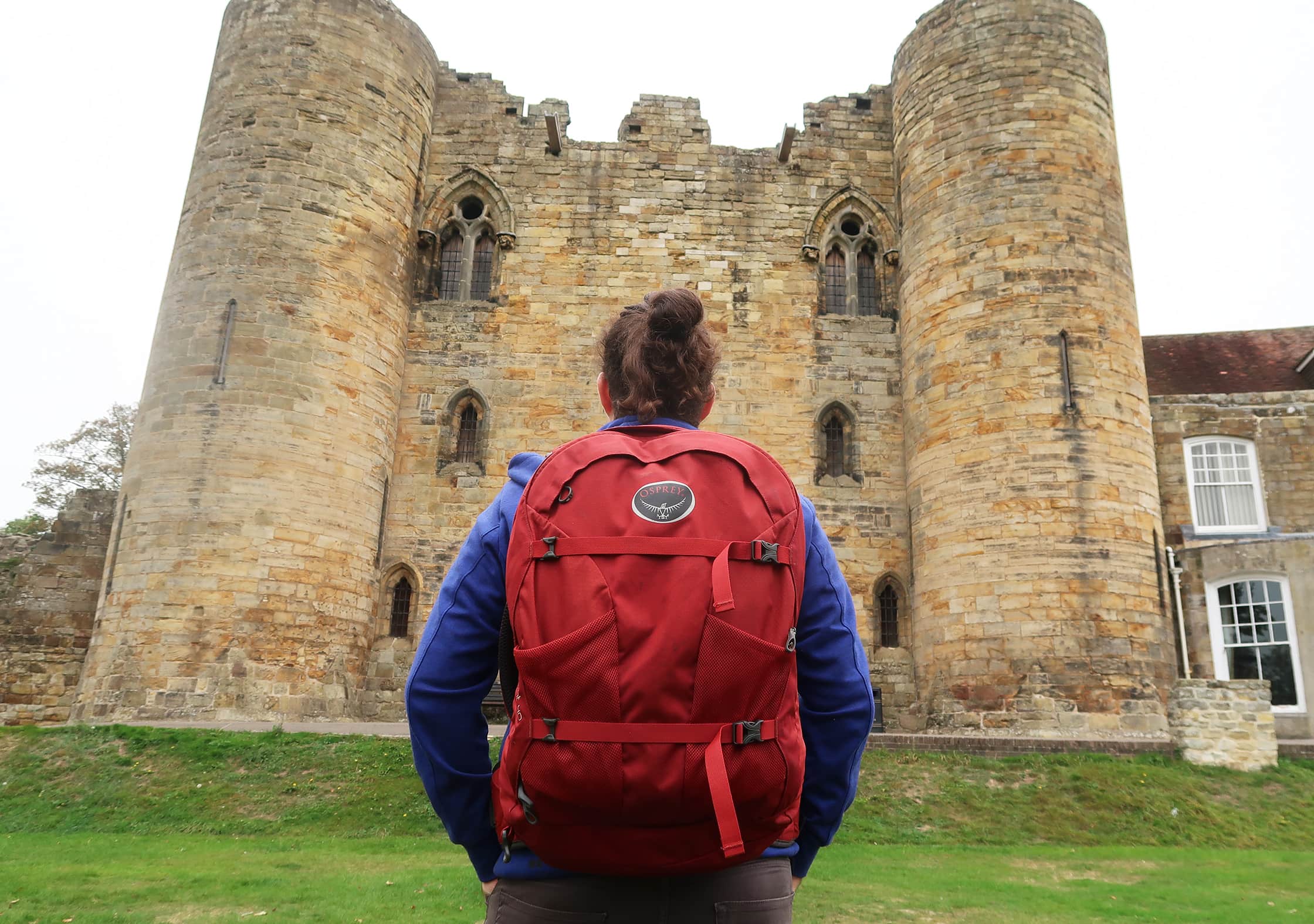
But before we dive into that question, we have to clear up one thing: this guide will be focusing almost entirely on carry-on luggage. Why? Well, we love to travel exclusively with carry-on luggage for a couple of reasons.
First of all, knowing that you have all of your gear on you at all times provides a certain level of freedom. If you’re traveling with only a carry-on, you don’t have to get to the airport early to deal with checking a bag, and when you get off the plane, you can head right to the airport exit without having to wait at the luggage carousel. You’ll also never have to worry about your luggage getting lost by the airline, and you’ll never have to pay extra fees to check a bag.
That being said, we can understand why someone might want to check a bag. You don’t have to lug around a heavy pack through the airport, and you can pack a lot more stuff by using a huge bag.
HOWEVER, we are confident that you can have the best of both worlds if you pack correctly! With the right gear and some know-how, you can perpetually travel the world with a carry-on that is light, comfortable and holds everything you need to live your best life.
The Luggage Debate
And now that we’ve cleared that up, we have one more thing to settle. Backpack or roller luggage? Duffel or suitcase? Let’s take a look at some pros and cons.
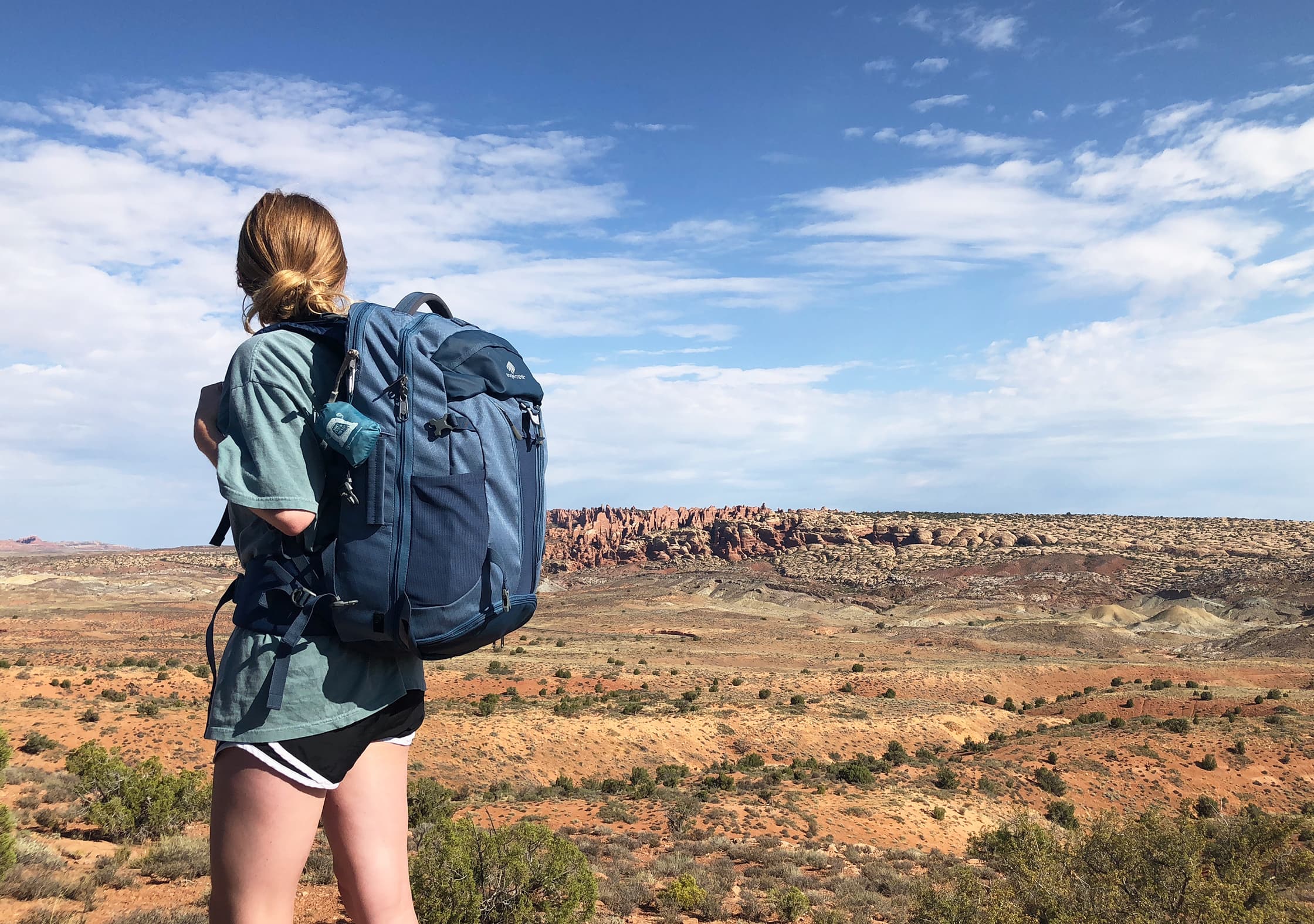
Travel Backpacks are nice because they allow you to be agile. You can fly past those slow-pokes on the left side of the escalator, you can climb mountains, you can hop over a puddle, you can walk down cobblestone streets, you can go for a stroll along the beach…you get the idea. These things are just not possible with roller luggage. Additionally, backpacks allow your hands to be free at all times and they typically have more organization than a suitcase. They have plenty of areas to stash things like a mouse, keyboard, pens, notebooks and more. Most suitcases don’t give you that option. And finally, they tend to be a bit more compact. If you don’t have your pack filled to the brim, you can usually compress it so that it takes up less space. Overall, backpacks tend to be less cumbersome than a suitcase.
Roller luggage, on the other hand, is a good option for those who may not be able to (or don’t want to) carry a backpack. There’s no denying that rolling along a piece of luggage is far less strenuous than carrying a backpack—so whether it’s due to a bad back or you just hate carrying backpacks, we understand that it’s not for everyone. Additionally, roller luggage tends to offer more rigidity than most backpacks, and it gives you a simple, structured compartment to pack all of your belongings. If you can’t stand the thought of your clothes getting wrinkled, roller luggage can help with that.
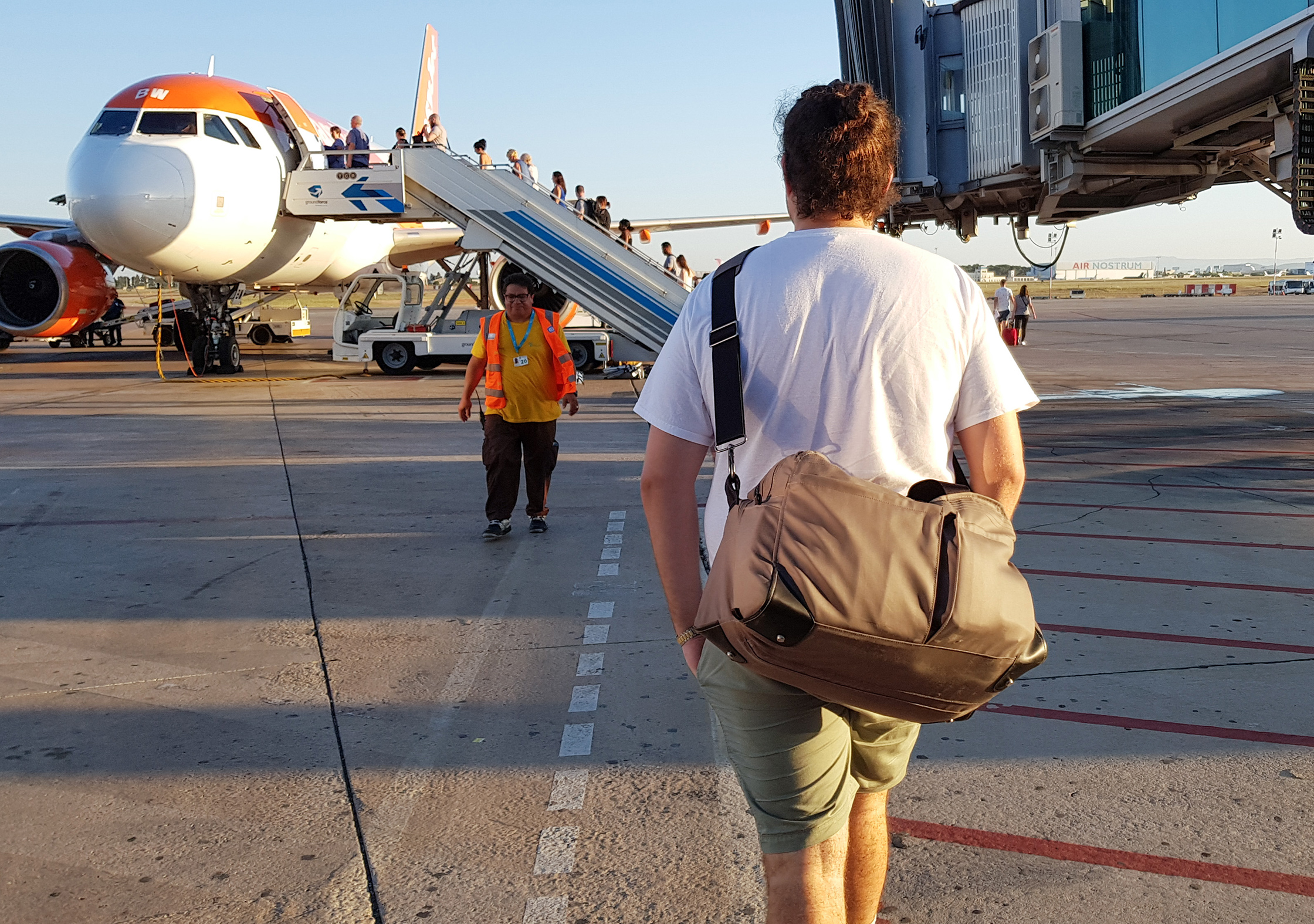
Duffel bags are good for holding a whole lot of stuff, but we tend to think the cons outweigh the pros. Duffel bags don’t offer much organization, they’re difficult and strenuous to carry, and they don’t have much structure, rigidity, or padding. Some duffel bags are multi-function—they might function as a backpack, duffel, and messenger bag. Unfortunately, we have yet to find a bag that does any of those as well as one that has a dedicated role. If you’re interested in a duffel for travel, we’d like to nudge you over to the proverbial backpack aisle.
Traditional suitcases are, to be honest, far from ideal. If you really like your old-fashioned suitcase for whatever reason, we’d recommend looking into one with wheels. It will make your life a million times easier. (We’re not exaggerating—we’ve done the math. A million. Times. Easier.)
We’re not here to tell you which one to choose, although we do think you should limit yourself to the two objectively “best” options—travel backpacks and roller luggage. And we’re not going to lie to you; we’re quite partial to backpacks—so you may see a slight bias towards backpacks in this guide. It’s in the name, after all.
However, if you’re traveling the world perpetually, we’d highly recommend going for a backpack due to the added versatility and freedom of movement. Traveling the world with roller luggage is a recipe for frustration and far too much cursing. We think the journey is half the fun, so you should do what you can to enjoy it.
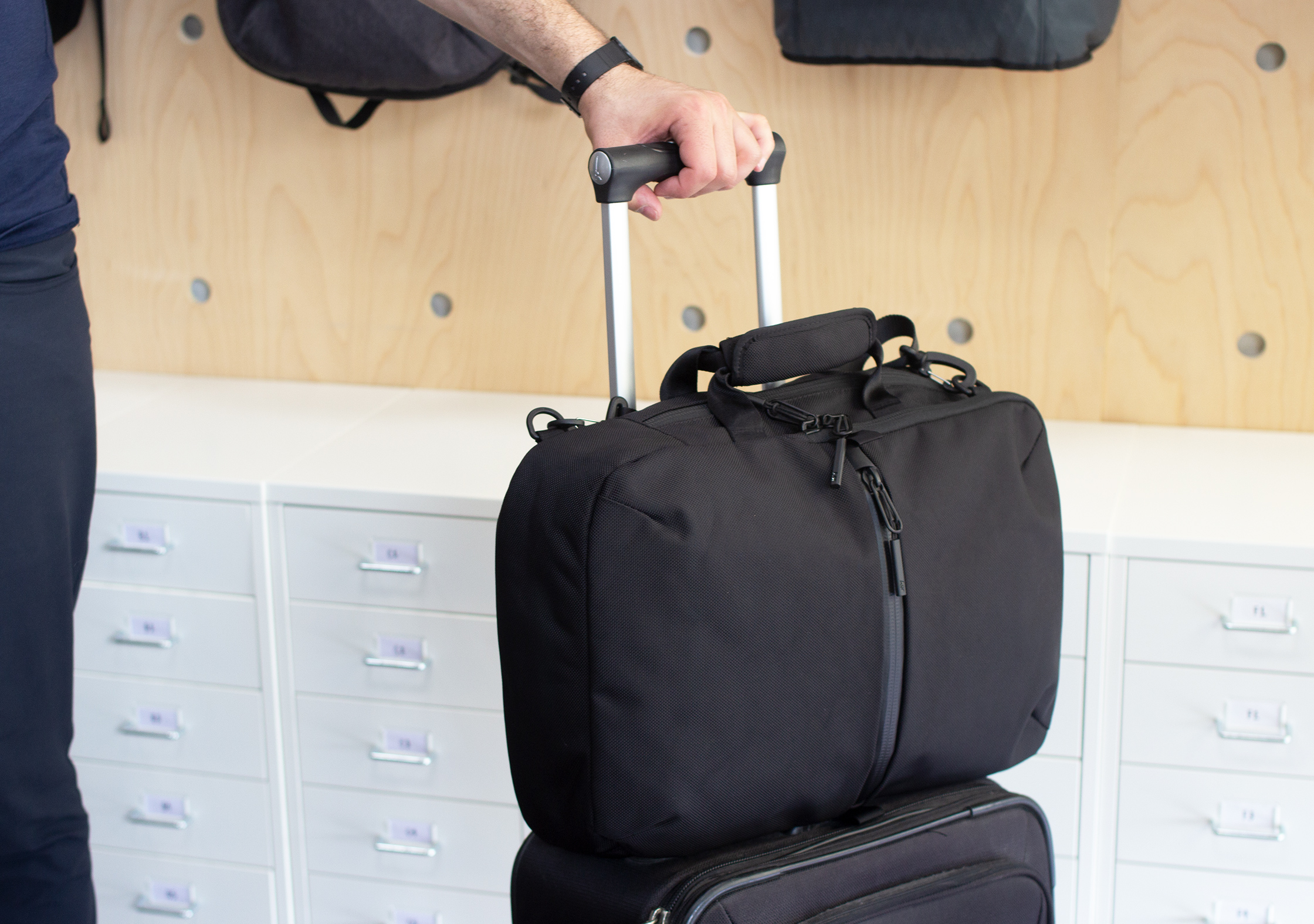
Luggage Considerations
When choosing the perfect travel backpack or luggage for your travels, you’re going to want to take size and versatility into consideration. The size will, obviously, designate how much stuff you can bring along with you. A larger bag means more room for luggage but more strain on your body and less flexibility. The smaller the pack, the fewer items you’ll need to lug along with you and the easier it will be to move around.
We tend to opt for a happy medium. Traveling ultralight with nothing more than a change of underwear and a toothbrush isn’t terribly enjoyable (at least, in our experience). In the same vein, traveling with a heavy pack that has everything you could need for every possible situation is usually unnecessary and frustrating.
15 to 25 liters is very much on the small side. This is good for weekend trips or extended travel for serious minimalists. For most people looking to travel perpetually, we’d recommend going a bit bigger.
30 to 40 liters tends to be the sweet spot. This is a good size that can easily fit everything you need for perpetual travel while possibly having some wiggle room left over, depending on how heavy you pack. With a backpack, you’ll start running into some nice options for organization here, if that’s your thing, or you can use packing cubes to organize things yourself. This is also the size where smaller folks might start needing to think about how the bag will actually fit on their back. Larger packs in the 40-liter range can be cumbersome for smaller frames.
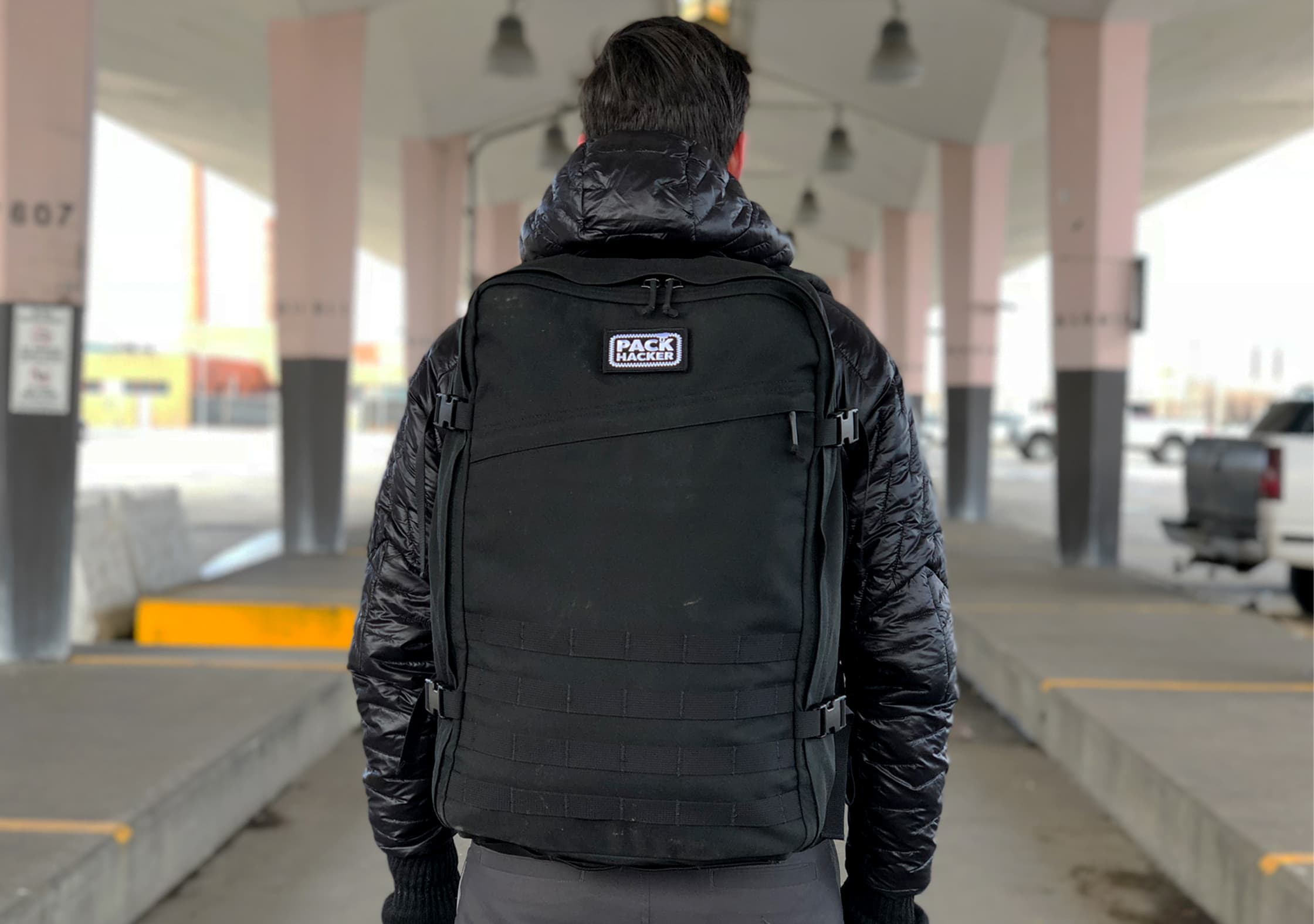
Over 40 liters is pretty damn large, and you’re going to start running into carry-on compliance issues here. Bags in the 40 to 50-liter range—like theGORUCK GR3—may claim they’re carry-on compliant, but we have our reservations (hah, travel puns). You’ll definitely want to be careful trying to use a bag of this size for carry-on travel, although it does give you a lot of freedom regarding what to pack.
As far as versatility goes, we have a few things to note. First of all, we like bags that have some built-in weather-resistance or a solid rain cover. This allows you to easily travel through varying climates and be prepared for just about any weather event that might occur. Weather-resistant materials are great for this, but weather-resistant zippers tend to make a huge difference. Good zippers will give you some peace of mind when that sprinkle turns into a downpour.
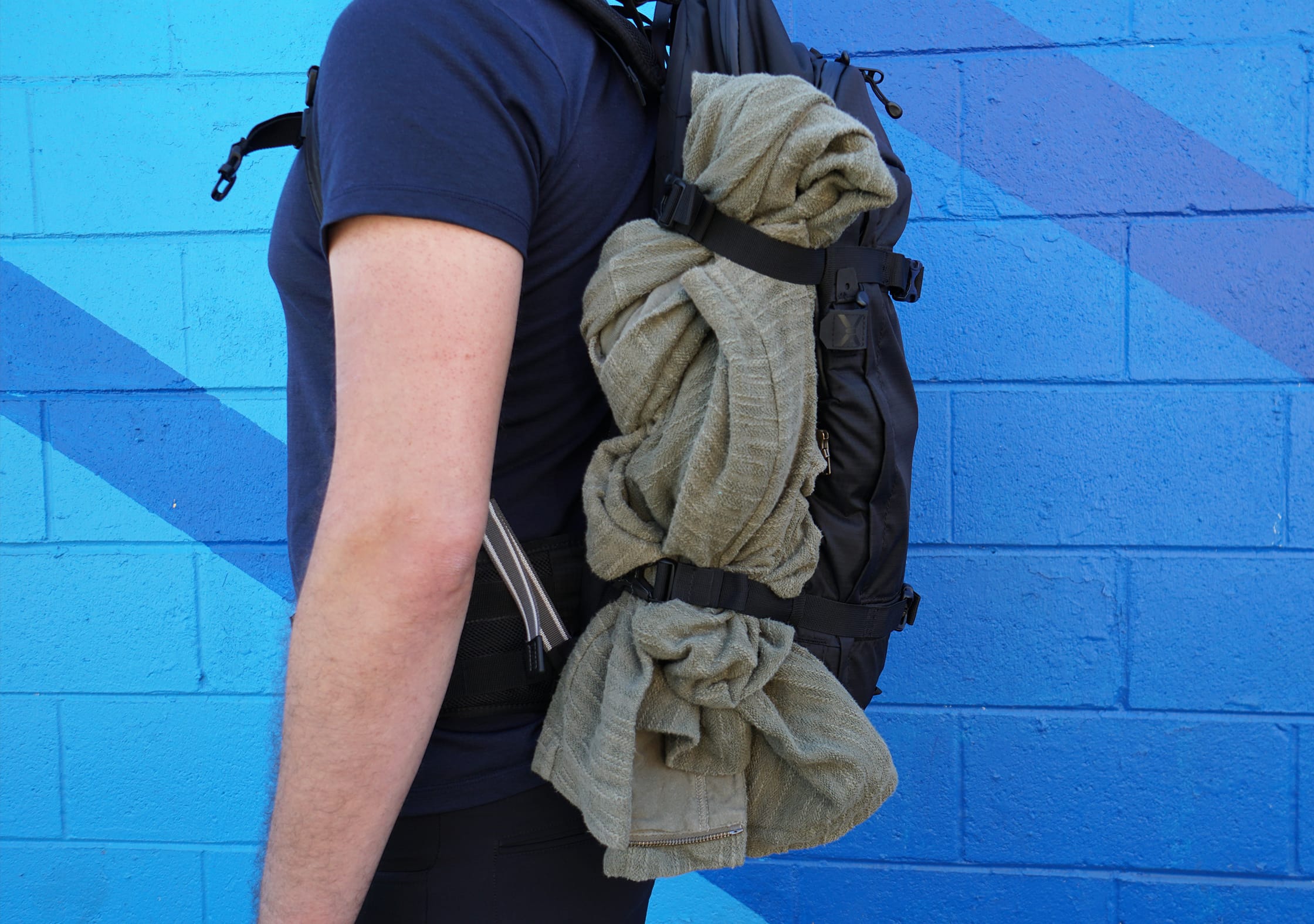
Some backpacks feature compression straps, which also add some versatility. These allow the pack to expand when full and compress down to a slimmer version when not—meaning you can compress a large travel pack down to something that will work well for shorter trips or a day out in a city. Some packs can compress quite a bit, effectively acting as a daypack and travel pack combined into one. (Another great method is to bring along a packable daypack, but we’ll get into that later on!)
Budget
Before we dive into all the nitty-gritty stuff, let’s talk for a second about how packing can affect your overall travel budget.
In the vast majority of cases, traveling with nothing but a carry-on compliant bag will save you money, but you should always do your research beforehand to avoid any surprises. Most airlines charge no extra cost for you to bring along both a carry-on item and a personal item; however, some airlines will charge varying fees for this and almost all charge for checked bags. It all depends on who you’re flying with, restrictions and prices vary.
Our best recommendation here is to keep your carry-on item well within the general carry-on restrictions, which are 22 inches high by 9 inches deep by 14 inches wide. When you see a backpack listed as “carry-on compliant,” they’re almost certainly saying it fits within these parameters. This means that your bag will definitely get through airport security in the U.S.
That being said, when it comes to size limitations, some airlines will have tighter restrictions and some will give you a bit of extra breathing room. All airlines have some kind of weight restriction, but there is no standard. Generally speaking, you’re highly unlikely to run into a weight restriction unless you’re carrying a lot of seriously heavy stuff—like camera equipment, rocks, or gym weights. (Sorry to all the photographer-mountaineering-weightlifters out there. You might want to check your bag.)
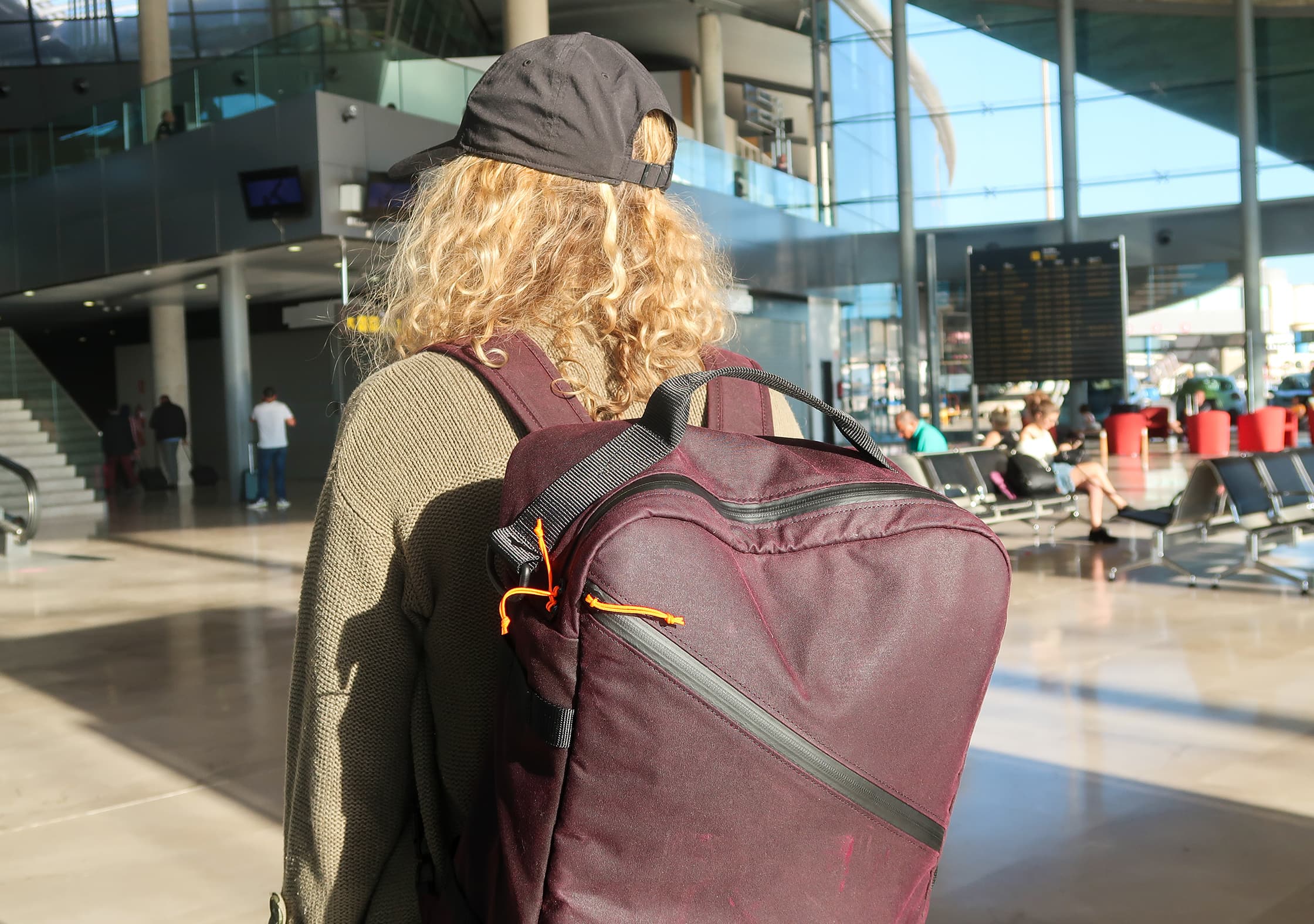
If you haven’t caught on yet, the main lesson here is to check your airline’s website before you fly. And when packing, try to keep things light and compact whenever possible to avoid having to check your bag. This is especially true if you’re traveling around the world, hopping from airline to airline, as one flight may make you check your carry-on, while another won’t.
And if you’re getting concerned about your bag not making it onto a flight—don’t. As long as your bag makes it through security, it is getting on that flight. You may get charged a fee, they may ask you to put it in the cargo hold, but you should never worry about being forced to leave it behind.
What to Pack: The Bare Minimum Essentials
If you’re choosing to show up at the airport with just the clothes on your back and the bare minimum (kudos to you ultra minimalists out there), here’s a list for you. These are the basic items every traveler needs to get on their flight and make their way to their destination.
If you’re not concerned with the details, here’s the rundown:
- A current passport
- A visa, depending on where, when, and how long you are staying in a country
- A local photo ID
- A boarding pass
- A printed itinerary (optional)
- Some cash (small bills)
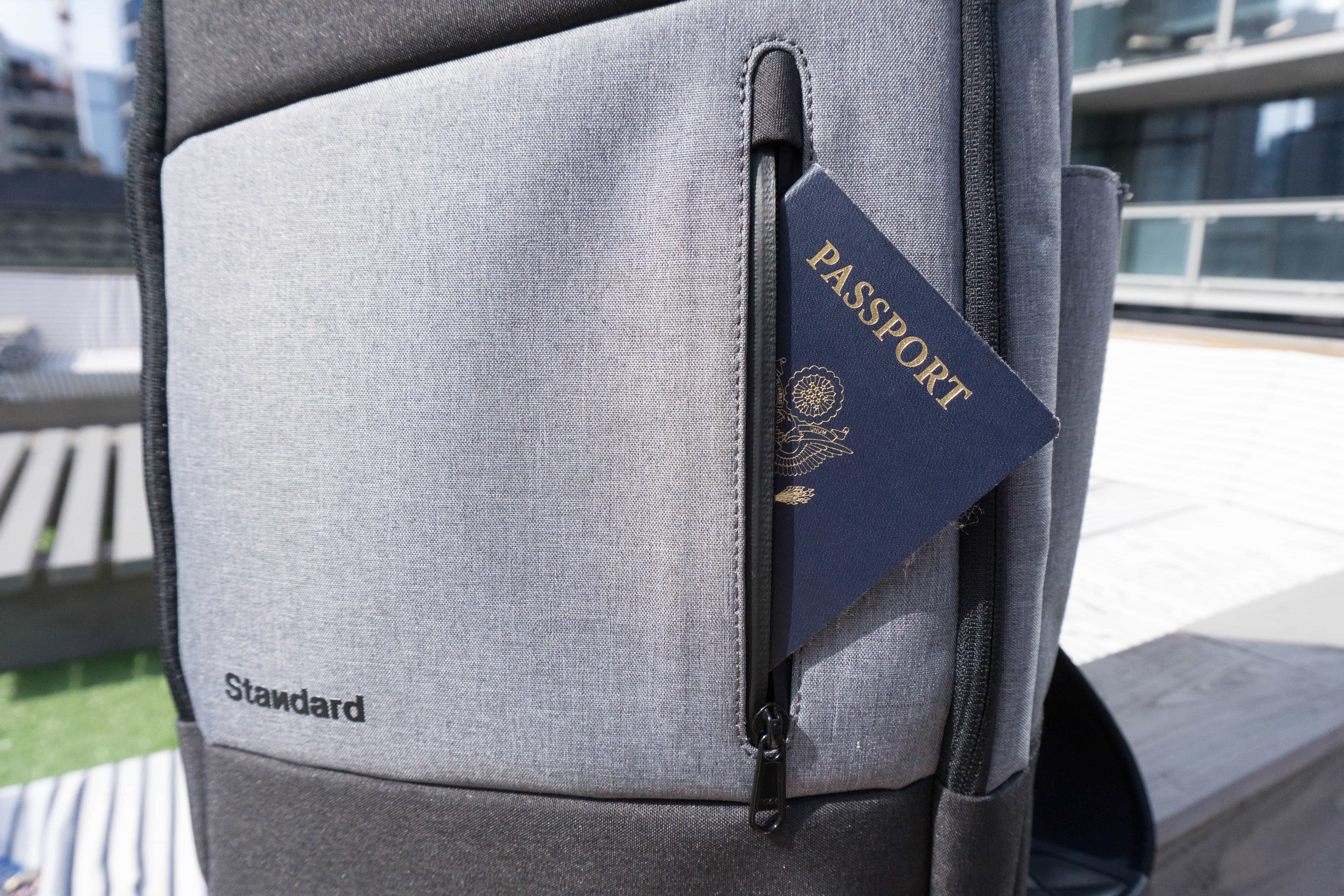
Traveling out of your home country? You’re definitely going to need a passport, and it needs to be current.
For U.S. residents, these typically take four to six weeks to process, so get ahead of the game! You will have to go through the application process and then wait for it to come in the mail. It is possible to expedite this process if you’re willing to fork over some extra cash or you have some extenuating circumstances where you need to have it sooner—but in general, we’d advise planning ahead. The easiest place to get this stuff done is typically a U.S. post office.
For all other countries, the specifics will vary, but the sentiment remains the same. Plan ahead. And make sure you are consulting an official government website in your home country to get the most accurate information and correct forms.
Finally, even if you already have a passport, make sure it won’t expire at any point during your trip or even anywhere near your trip. If your passport is current at the time of your departure, but it is going to expire during your stay, you won’t be able to get into the country. Or, if for some reason you do get in, you might have trouble getting out!
Depending on where, when, and how long you’ll be in another country, you may also need to apply for a visa. There are a whole lot of requirements and stipulations to get a visa, and they all vary from country to country. We’re not going to dive into this, but just know that in most scenarios, you’ll be fine traveling to a country for less than 30 days without a visa. Over 30—and especially over 90—and you should really do your research. You’ll likely need one.
In addition to a passport, you’ll want to bring along your local photo ID. This may come in handy at the airport and in other travel scenarios—like buying alcohol, renting a car, or getting into age-restricted events. At the very least, you’ll want to have one as a precautionary measure. It’s always good to have two forms of ID in case you lose your passport. Typically, this takes the form of a driver’s license or student ID.
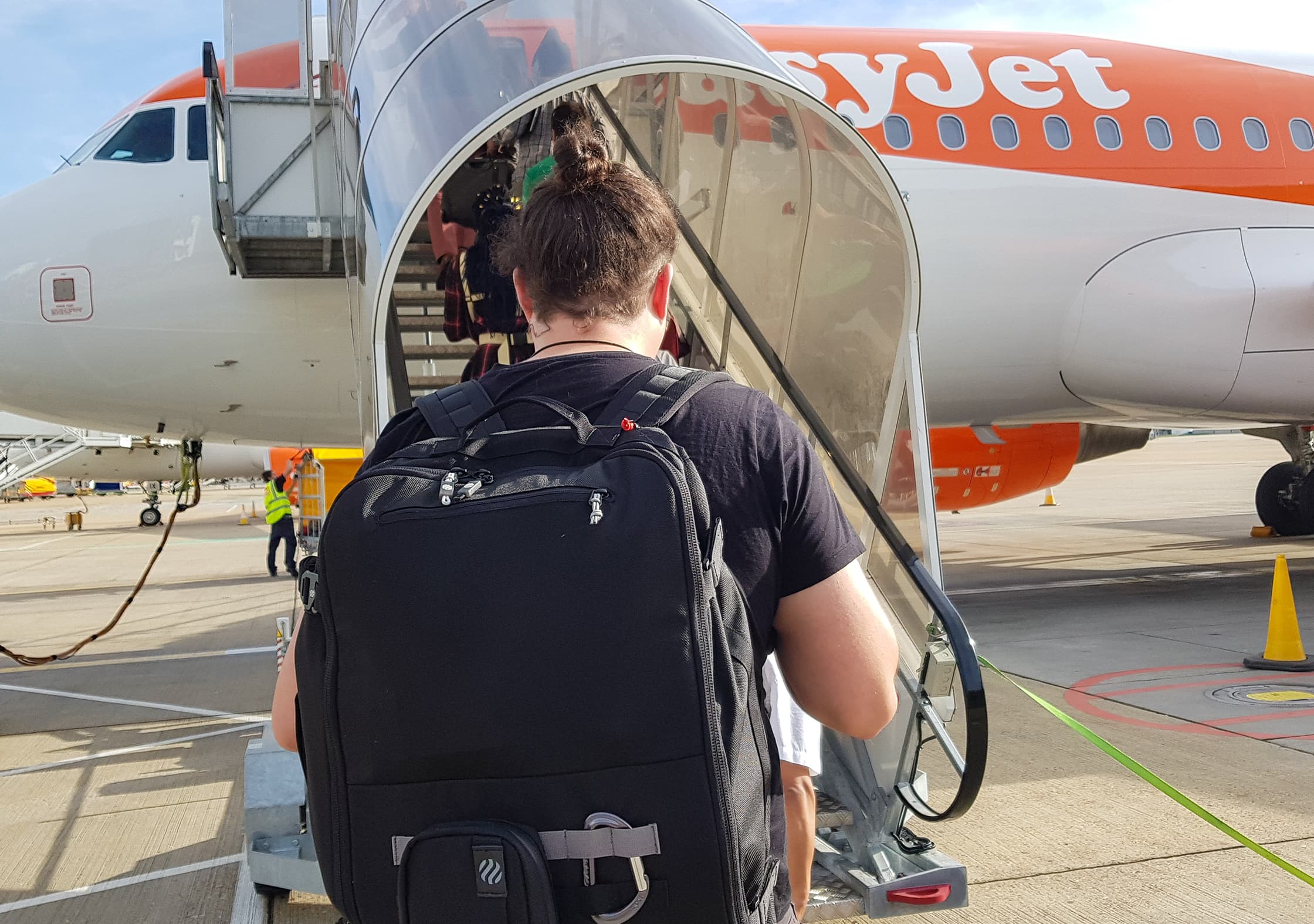
Regardless of where you’re going, you’ll need your boarding pass. You’ve got some options on how to approach this, and the good thing is they’re all relatively easy. We think some people stress out too much about boarding passes—in reality, they’re very easy to deal with.
- Mobile: You’ll likely get the boarding pass sent to you as an email, so you can access it from your smartphone’s inbox if you have an internet connection. However, we’d recommend either downloading it to your phone’s “wallet” or taking a screenshot of the QR code so you can access it without an internet connection. (Just in case you don’t have service at the airport.)
- Print: You can opt to print your boarding pass from your own printer beforehand. This can be tricky if you can’t find a printer, but if you do have access to one, it’s a foolproof way to make sure you’ll have it for your flight. (For the digital nomads—try asking about a printer at your local coworking space! Most places will let you print a few things for free.)
- Kiosk: When you get to the airport, you can print out your boarding pass by using one of the self-serve kiosks near your airline’s customer service area. Usually, you just have to input your name and flight info. We think this is a seriously underrated option—you don’t have to do anything beforehand, it’s simple, and we’ve never had a problem with lines.
- The Counter: Just like the old days, you can still go to your airline’s customer service counter (where you check a bag) and have them print your boarding pass out. We’d highly recommend against this, as there will almost always be a line. If you need to check a bag, though, it can make sense to bundle it all in one trip.
You may also want to print out your itinerary. Serious travelers might balk at this, but we still like to print out our itinerary sometimes, especially if things are a bit complicated. Between connecting flights, Airbnbs, and car rentals, it can be nice to have all the info you need in one place on a physical piece of paper. This is especially true if you’re ever going to be crunched for time during your trip—like making it to a business meeting right after your flight.
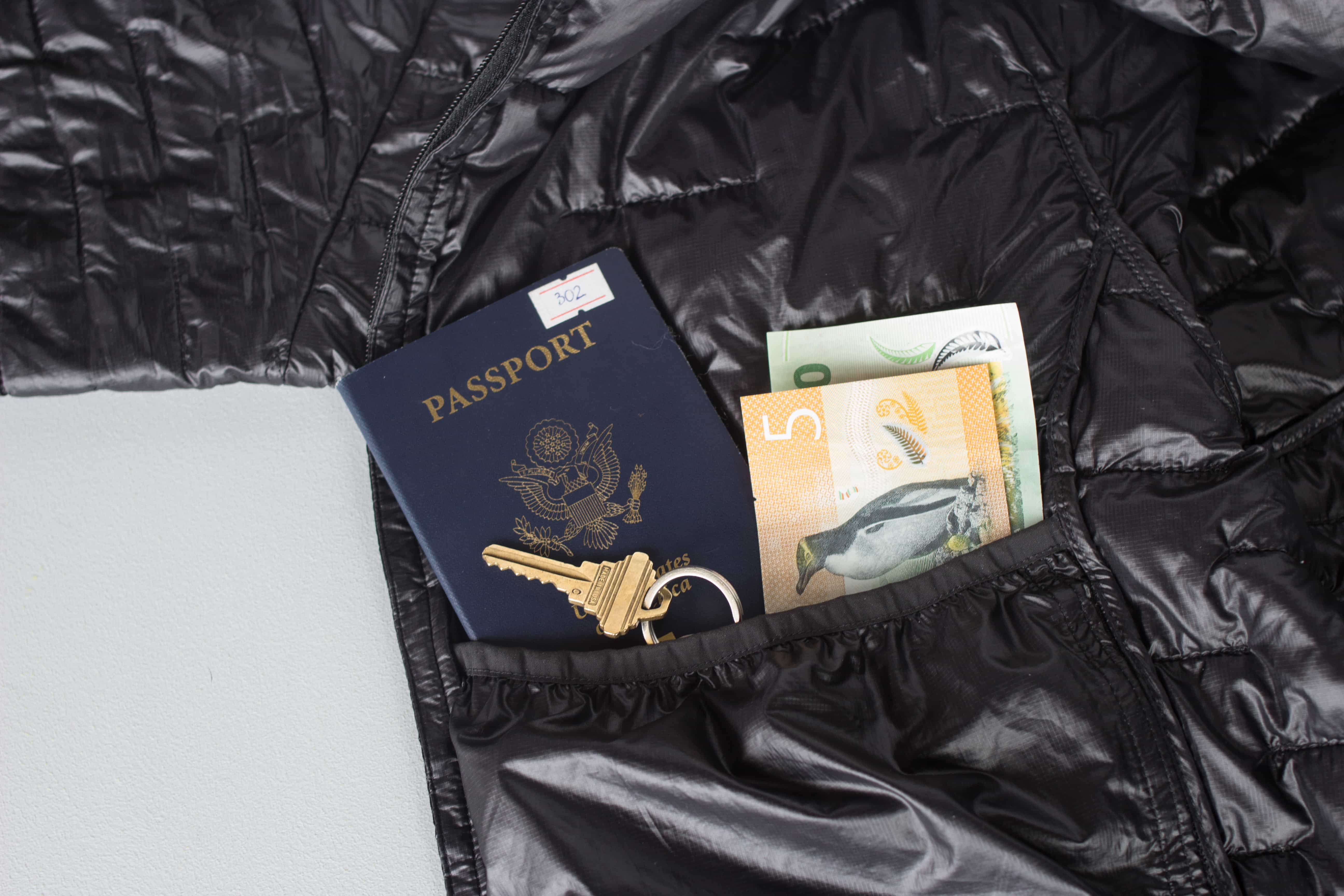
Cash can come in handy while traveling, so we usually like to bring a couple of small bills—in both our home currency and the currency of our destination—to the airport for the first leg of our journey. However, we don’t recommend carrying around large amounts. Stick with small bills and grab yourself a travel-friendly debit and/or credit card. Some offer great travel benefits!
If you know your destination before departing, you can also visit your local bank ahead of time to grab a lower exchange rate on cash, instead of wasting the extra buck or two on this once you arrive.
These are the bare minimum essentials you’ll want and need to bring along for your travels. These are also the first items we tend to set aside while planning and packing for our trip, to ensure we have them when we hit the road. Now…let’s pack that bag!
An organized pack makes for a happy trip.
With gear for any traveler or adventurer, you can find something for everyone on your gift list. Check it out →
How to Pack the Right Way
Do you know what the difference between a frazzled traveler and a calm, collected, professional traveler is?
ORGANIZATION!
The simplest step you can take towards retaining your sanity and ensuring a stress-free journey is to keep all your belongings well-organized. An organized pack makes airport security a breeze, among many other things. You’ll be able to pull out everything you need from your pack at a moment’s notice, and because you’ll never be wasting time trying to find anything, you’ll never fall behind schedule. And because you’ll always be ahead of schedule, you’ll never be in a rush. Which also means you’ll be far less likely to lose anything. Plus, it just feels damn good.
What we’re getting at here is that an organized pack makes for a more enjoyable travel experience!
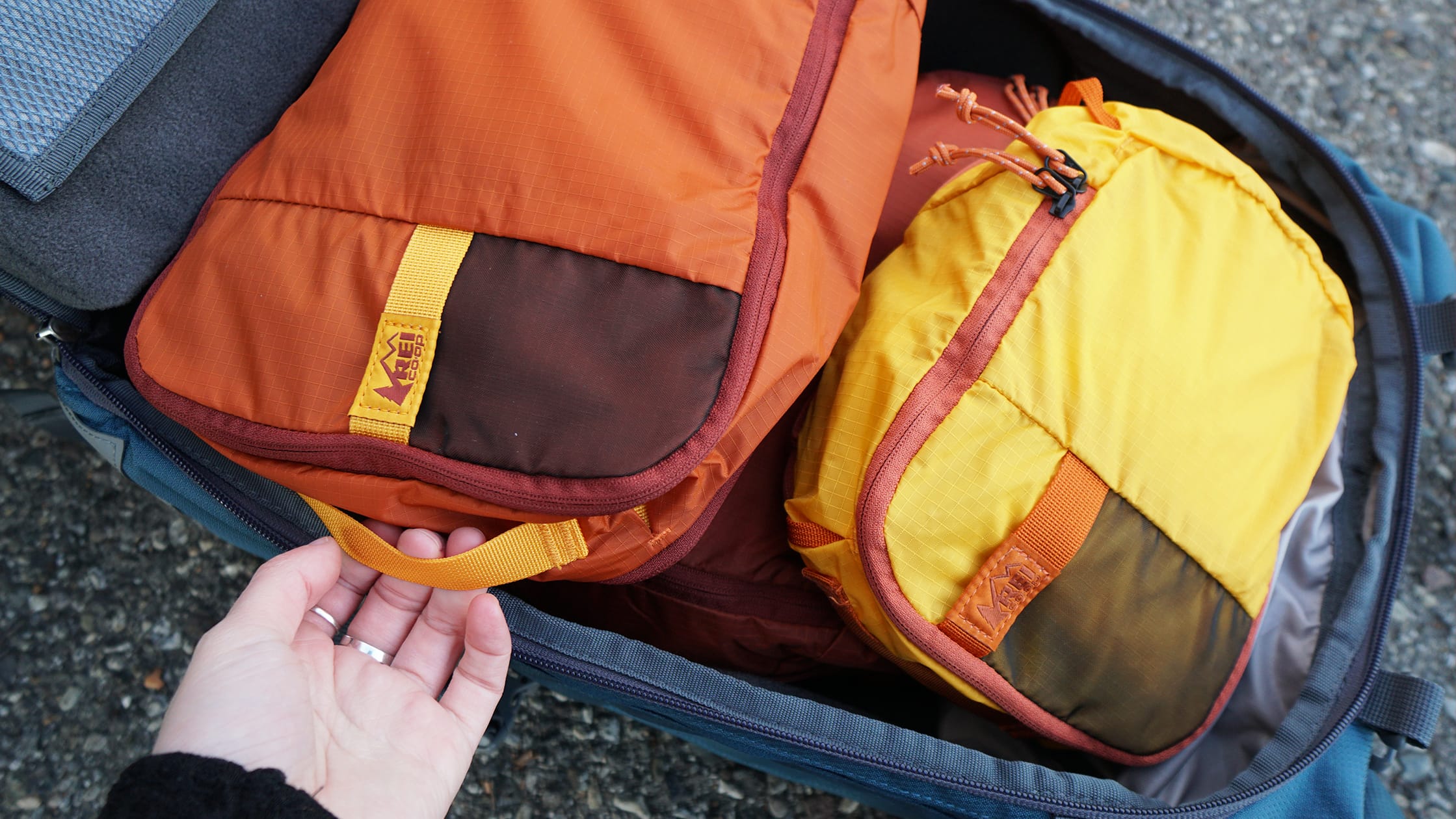
The key to keeping an organized pack is compartmentalization. And the key to compartmentalization is packing cubes, pouches, and Dopp kits.
Why Packing Cubes?
Packing cubes are one of our absolute go-to travel items. We almost always use them, no matter what or where we are packing for. With packing cubes, you can organize and compress your gear, keeping your bag tidy and saving space.
We’re not going to go in-depth on packing cubes in this guide, but we will talk for a minute about how to best use them. There are basically three trains of thought, and none of them are right or wrong nor are they mutually exclusive. You could use one method or a mix of both to create a system that works for you. It’s really up to personal preference.
- Pack by outfit: You can pack one or multiple outfits into each of your packing cubes. That way, when you want to wear a certain outfit, all you need to do is pull out that cube and get dressed.
- Pack by item type: Some things just make sense to pack with each other. You can toss underwear and socks into one cube, t-shirts into another, and pants or shorts into another.
- Pack by frequency of use: If you’re only going to be wearing your warm jacket and socks for a few days during your trip, it might make sense to pack that stuff into one cube and toss it in the bottom of your bag. You can keep it out of the way and keep your other gear more accessible.
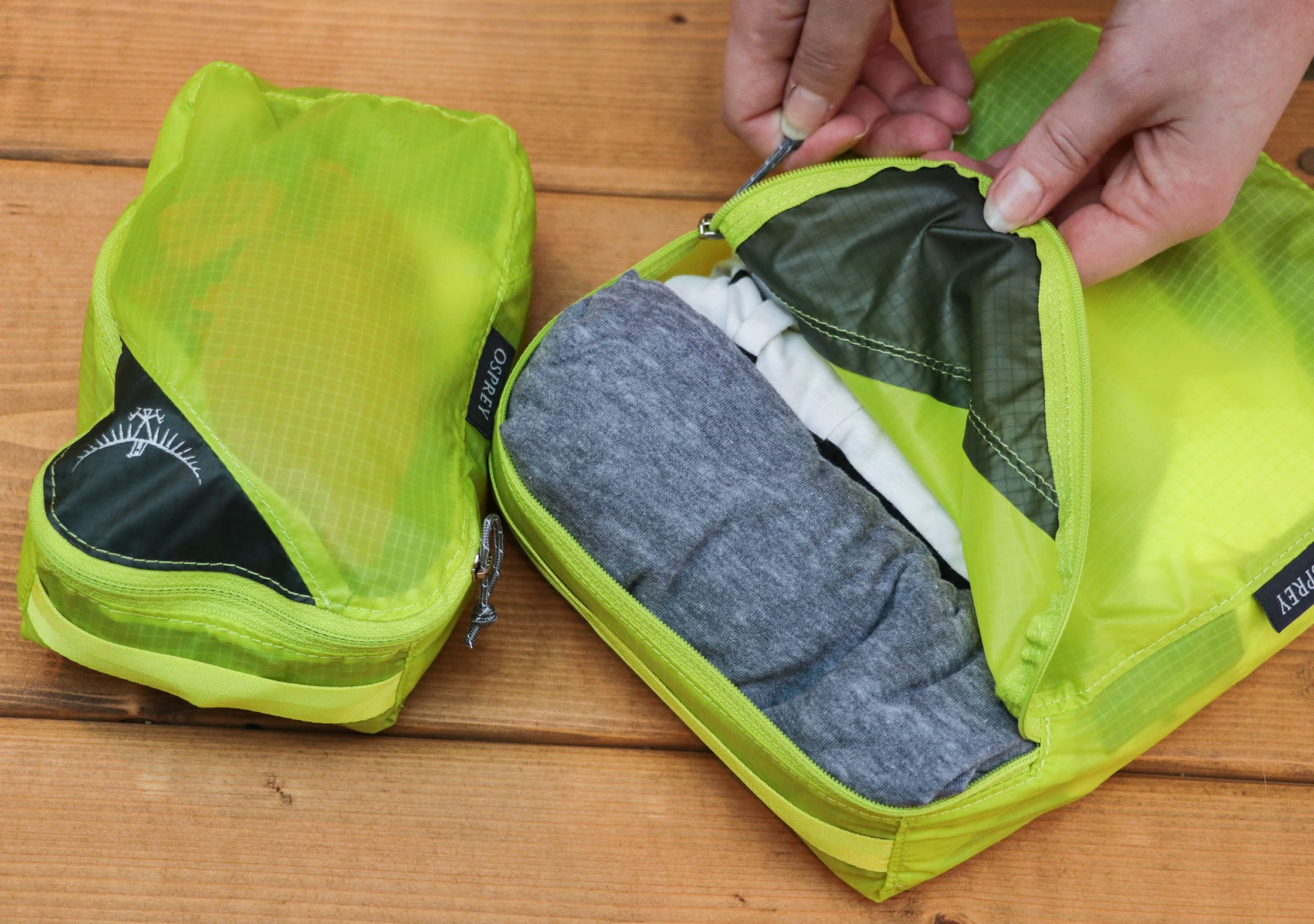
Trust us on this one, if you do use packing cubes, you’ll thank yourself when you arrive at your destination with a perfectly organized bag.
It also might take a few trips to find a system that works for you—and that’s okay. We’ve actually found it helpful to practice your trip beforehand by packing up your bag just as you would for travel, and going about your daily routine with nothing else but what’s in the bag. This is a good way to figure out what items you need and don’t need, but it will also help you find a packing cube system that makes sense.
Dopp Kit / Toiletry Bag
Instead of throwing all your toiletries into a packing cube, we suggest utilizing a Dopp kit or toiletry bag.
FUN FACT: Dopp kit is a term for toiletry pouches that is commonly used in the United States, and we have Charles Doppelt to thank for it. His company (Dopp) designed small pouches that were issued to U.S. soldiers during World War I and II, and they became widely known as “Dopp Kits.” Now you’ve got a great little factoid for your next cocktail party. (You’re welcome.)
Like the rest of your packing situation, organization is key here—no one wants to dump out their entire toiletry kit to find their daily vitamins at the very bottom. If you utilize a Dopp kit with some organization, your mornings will run smoothly, and you’ll be able to find all your items at a moment’s notice. (It’s the little things that can make or break your morning routine!)
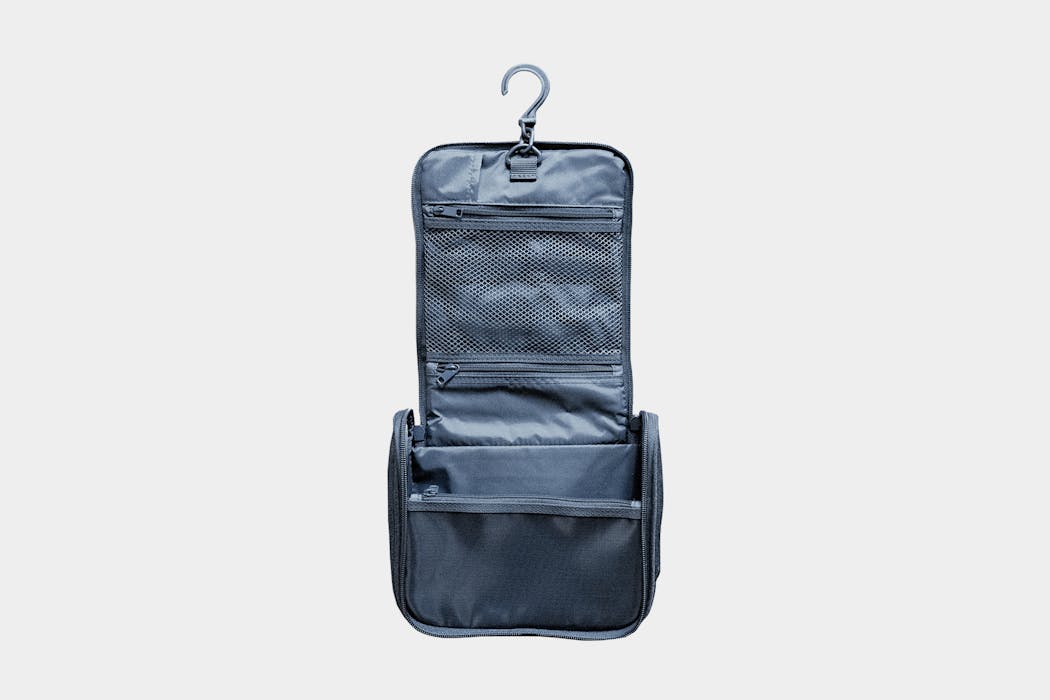
We’ve found Dopp kits with internal organization and a hanging mechanism—like the Muji Hanging Travel Case—to be stellar options. You can hang one of these bad boys up in your Airbnb, and you’re ready to go for the rest of your trip. No unpacking, no spreading your stuff all over the counter—everything is right where it needs to be, and when it comes time to leave, you can close it up and be on your way. Mesh pockets are key as they let you see where everything is at a glance, and we also like to have a few elastic keepers to hold smaller items in place.
What to Pack In Your Personal Item
As we discussed in the introduction, many airlines allow you to bring one personal item on board for free, in addition to your carry-on. We say “many” because, although rare, some budget airlines will charge you a fee for bringing a personal item.
Your personal item can be any small bag, like a daypack, purse, sling bag, or fanny pack (which is no longer just for dads stuck in the 80s, by the way). For the most part, when you board the plane, you’ll want to place your carry-on into the overhead bin and take your personal item directly to your seat with you.
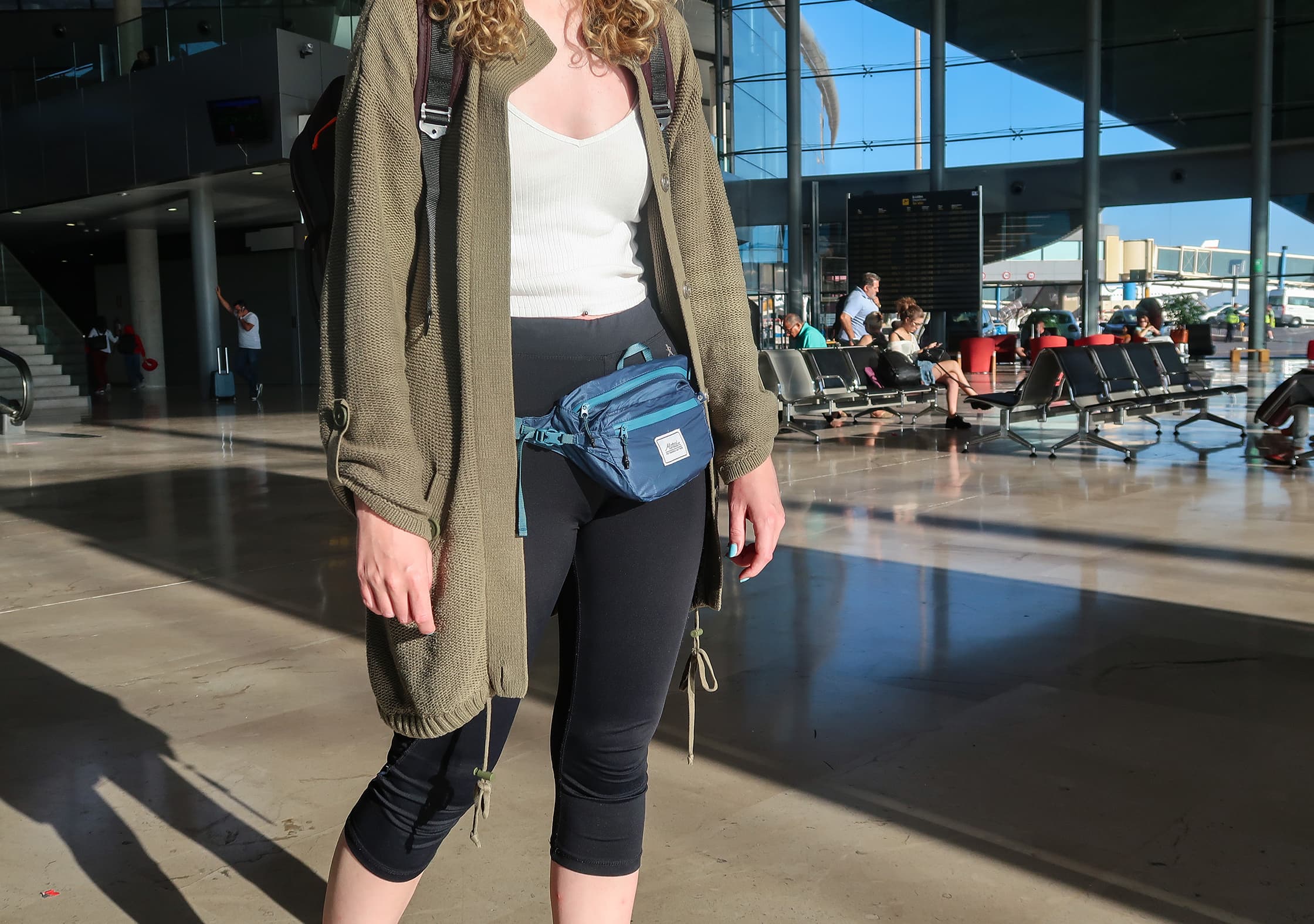
Choosing the right stuff for your personal item is essential to having a stress-free—and ideally, relaxing—flight. Feeling a headache coming on mid-flight? Well, if you packed right, you’ll have your Tylenol or essential oils in a quick zip. Need to drown out the sound of that crying newborn two rows behind you? Your noise-canceling headphones are just a zip away—whew.
Here is a quick list of what you’re almost guaranteed to find in one of our personal items:
- A smartphone: This is pretty self-explanatory.
- Water/drinks: Hydration is a major key to success, both in travel and in life. We like to have our own supply of water, rather than relying on the drinks cart that comes by every now and then during some flights.
- Snacks: We recommend avoiding the typical in-flight or airport food because 1) it’s usually not very healthy and 2) it can be ludicrously expensive.
- Toothbrush & Toothpaste: For some reason, your breath seems to get exponentially worse on a plane. Freshening up with a quick brush halfway through your flight is a luxury that cannot be underestimated. Trust us on this one.
- Eye Mask: Sleeping is great. But sleeping on planes, especially during the day, can be tricky—an eye mask can help.
- Earplugs: Another great sleeping accessory. Also can be used to passive-aggressively let your neighbors know they’re being a bit too loud. (Just make a big deal out of putting them in, and they should get the message.)
- Bluetooth Headphones: We love Bluetooth headphones because cords are a pain to deal with in transit. Bonus points if they’re noise-canceling, although we still love our Apple Airpods even though they don’t have any noise-cancelling. They’re just so damn convenient!
- USB Cables: Some planes offer outlets for charging, although we’ve found they’re often broken. Either way, you’ll want to have a USB cable (or two) on hand.
- Phone/tech charger: A USB cable and outlet isn’t much good without a charger. Smaller is better here.
- Battery Bank: If you don’t have an outlet on your plane—or if yours is broken, which is likely—a battery bank is great for keeping your electronics topped off. We like the selection from Anker.
- Pen: You never know when you’ll need a pen. But when you do, you’ll be glad you have it.
- A small notebook: See above!
- An eReader or tablet: We love eReaders because you can fit (literally) thousands of books on them and they weigh next to nothing. Tablets are also great for loading up Netflix and other media (just make sure to download it locally before your flight!).
- A book: Sometimes there’s nothing like a good, old-fashioned book. No WiFi, no battery, you can always count on this one.
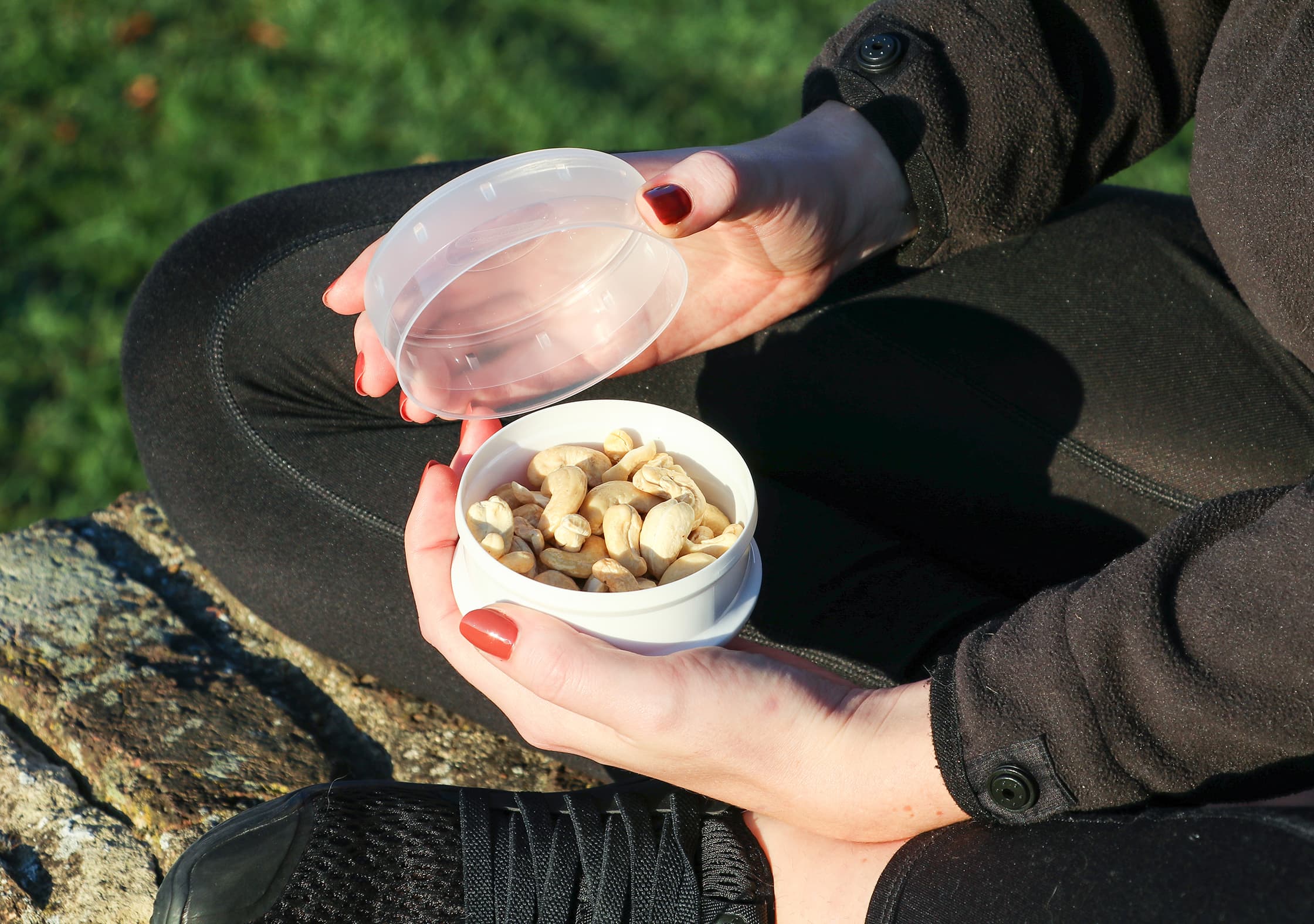
We consider those to be the essentials for a well-stocked personal item. You might not need every item on that list, but we guarantee you’ll want at least a couple, if not most of them. But that’s not all! We have a few other honorable mentions which are not entirely essential, but some people swear by them.
Compression socks can help increase circulation while in flight, reducing the risk of swelling. If you’ve ever noticed this happening on long flights, you might want to look into getting a pair and keeping them in your personal item.
Neck pillows make sleeping on a plane a whole lot more comfortable. We don’t typically use travel pillows because they’re not very versatile and add some extra bulk, but to each their own. Inflatable may be your best bet, as they weigh very little.
Motion sickness medication can be helpful for obvious reasons, although if you need this stuff you’re probably already well aware. One of our team members sat next to a man who barfed all over himself as soon as the plane landed. Do everyone a favor and don’t be that person, if you can help it.
Sleep aids are also helpful for obvious reasons. If you’ve got a red-eye and you know you have trouble sleeping on planes, do yourself a favor and grab some Benadryl, Melatonin, or—if you’re really serious—Ambien to knock yourself out and arrive at your destination feeling refreshed. PSA: We’re not doctors! Do your research and talk to your doctor before you take any new medication!
Gogo Inflight or other in-flight WiFi tools can be great for digital nomads working on the go. But we know what you’re thinking—“Hey! That’s not something I can put in my personal item!”—and you’re right. But if you do have one of these accounts, you should make sure you have the password written down on your phone or a piece of paper. If you have it saved in your web browser or in a password manager, you might not be able to retrieve it without internet. It’s a real Catch-22 scenario, and we’re a bit ashamed to say we know this from trial and error.
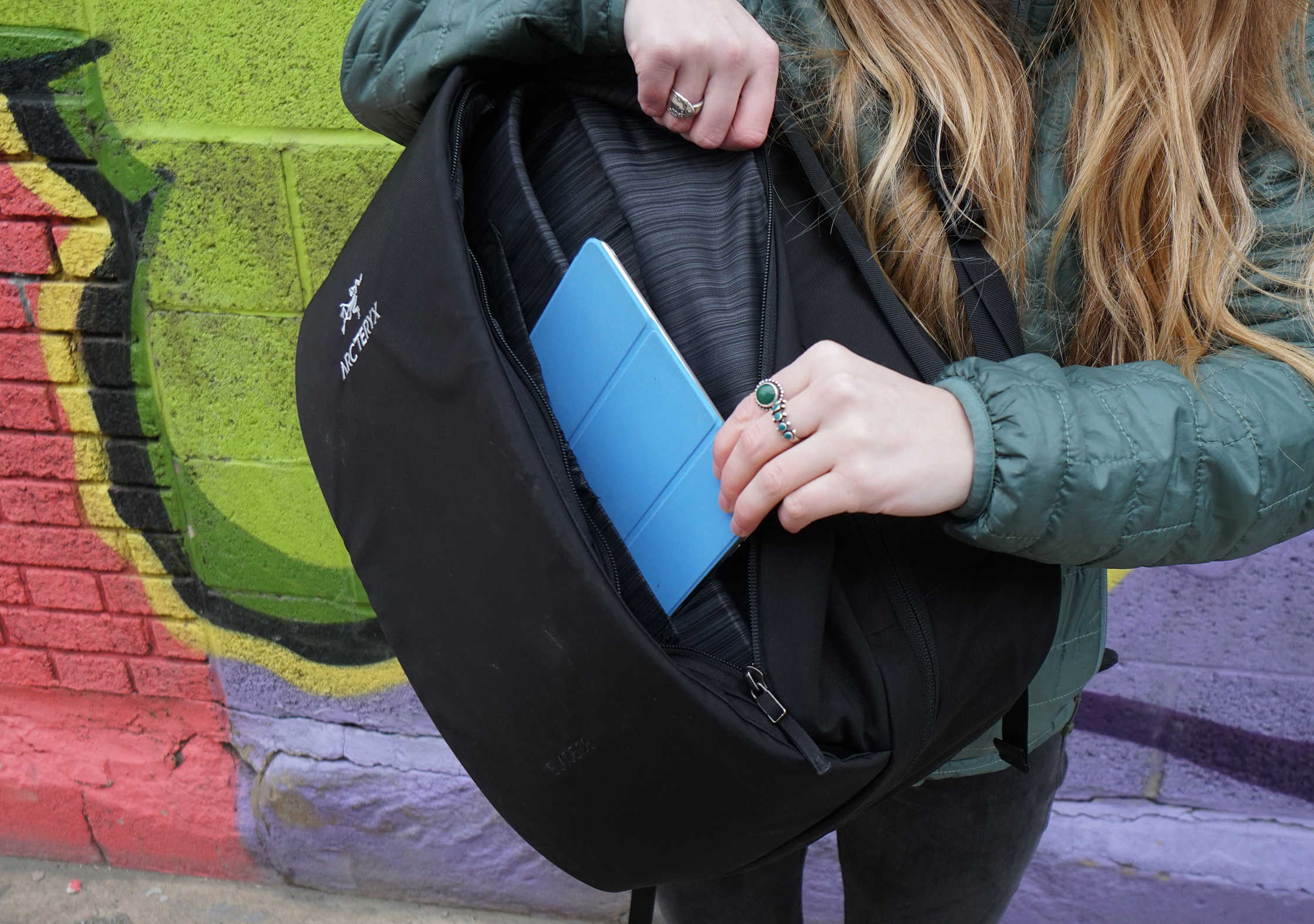
The stuff you need to stay alive while on the road. Minimalists rejoice!
With gear for any traveler or adventurer, you can find something for everyone on your gift list. Check it out →
What To Pack
If you’ve tackled choosing a travel bag and set of packing cubes (highly recommended) then you are ready to start filling them up with essentials. There are many different occasions and places to pack for, not to mention packing for your own personal style and needs, so we’ll do our best to guide you through the basics. We’ll give you our top gear recommendations and the info you need to make an educated decision. (Which is really what we’re all about—this stuff is your decision at the end of the day.)
Keep in mind, we’re keeping things pretty general here. We’ll have more specific packing lists for individual travel styles and preferences coming soon. Check back or, better yet, sign up for our newsletter to stay up to date.
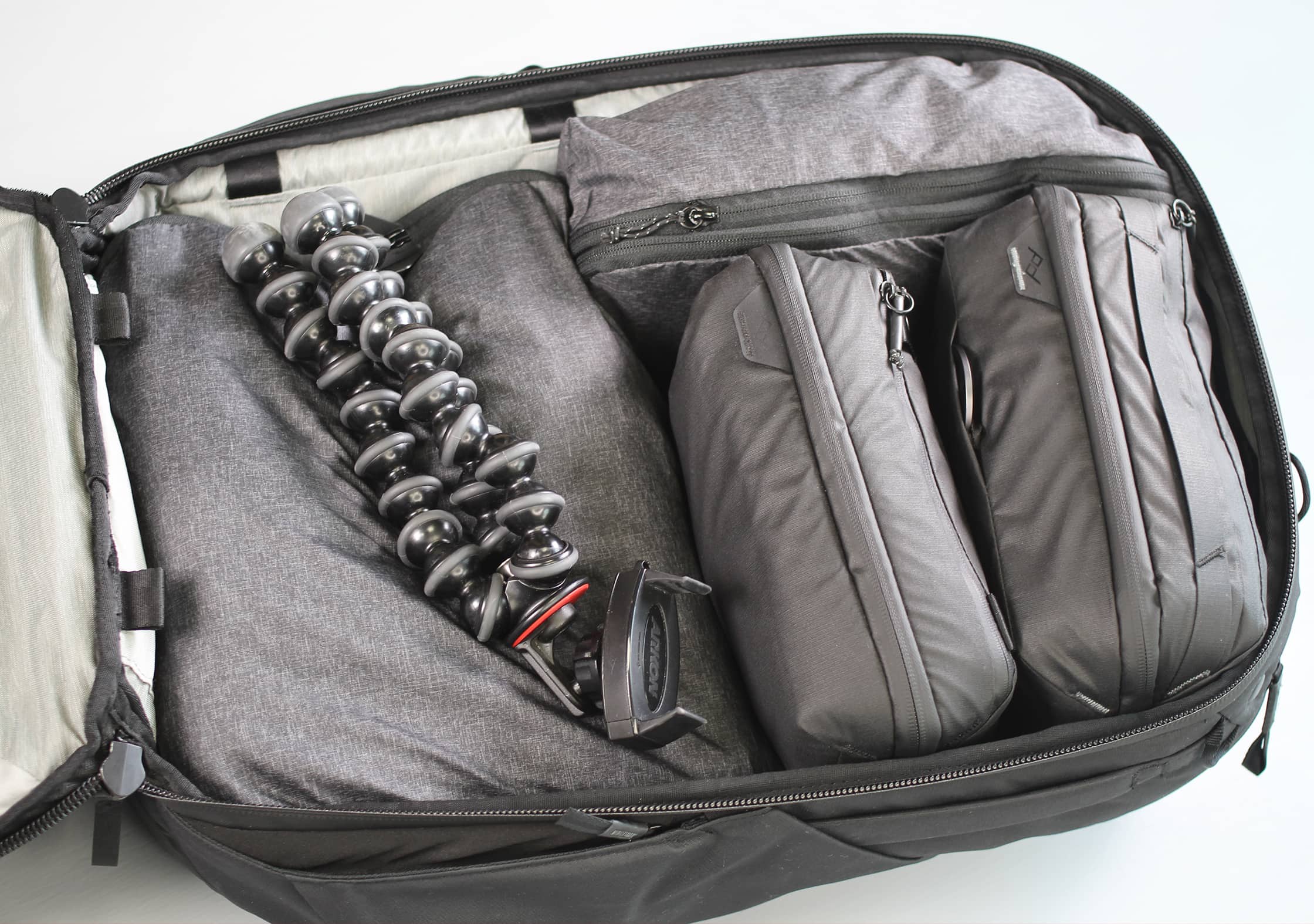
In any case, in order to optimize your luggage, we recommend packing the most versatile items and pieces of clothing you can muster. This could be anything from a shirt you can wear 20 days in a row without washing—we didn’t believe it either, but it really works—or a shirt you can wear five different ways. There are some pretty nifty pieces of travel gear out there and we’ll help you find the best. Let’s get packing!
(Are we the only ones that get excited about packing? It’s not just us, right? …Right?)
Clothing
We’ll start with clothing essentials. The amount of clothing you bring is dependent on how long you plan to travel for, so we’ll stick to the basics here. You’ll likely want these pieces to be as versatile as possible—think merino wool and neutral color schemes that you can wear in a bunch of different combinations.
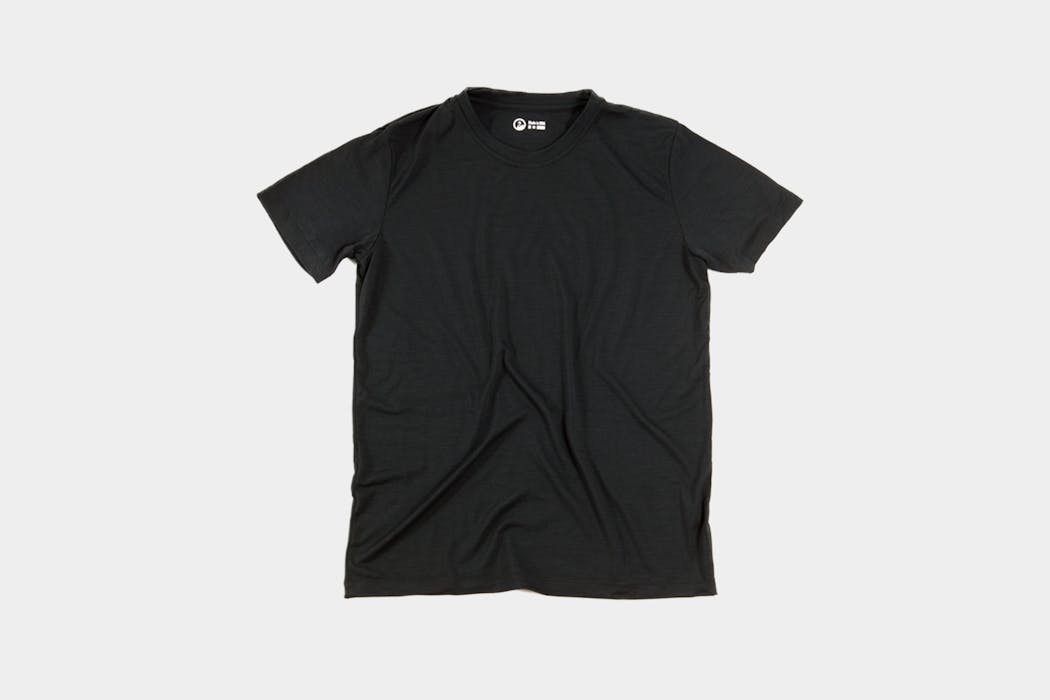
Soft, durable, and functional for workout & daily wear—the Outlier Runweight Merino T-Shirt is great, but the new version generates more pilling than we’d like to see.
The durability and quality of the clothing you choose is incredibly important here. You won’t want your t-shirt to develop holes twelve days after the first wear if you plan on traveling for a whole year. Pay attention to the materials each item is made with and be particular about the sizing. You are going to want these items to fit as comfortably as possible, as you’ll likely be on the move in them a fair amount.
We’re big fans of merino wool blends for travel, but really any other breathable, moisture-wicking fabrics will do. One thing you should know is that merino wool can go unwashed for several days—even weeks or months—without smelling. That’s one reason why it has become one of our trusty go-to travel fabrics.
Cotton is one fabric we try our best to stray away from when packing. It tends to dry slower, retain smell, and it’s less breathable than other fabrics on the market. But we’ve got to give credit where credit is due—cotton is damn comfortable, and it’s cheap. There’s a reason why 90% of t-shirts are made from cotton, after all. If you’re going on a short trip, cotton should be fine. If you’re traveling the world or taking an extended vacation, merino wool is worth the investment. Linen is also another cotton alternative that is comfortable, lightweight, and versatile.
Variations for the Everyday Twist Top
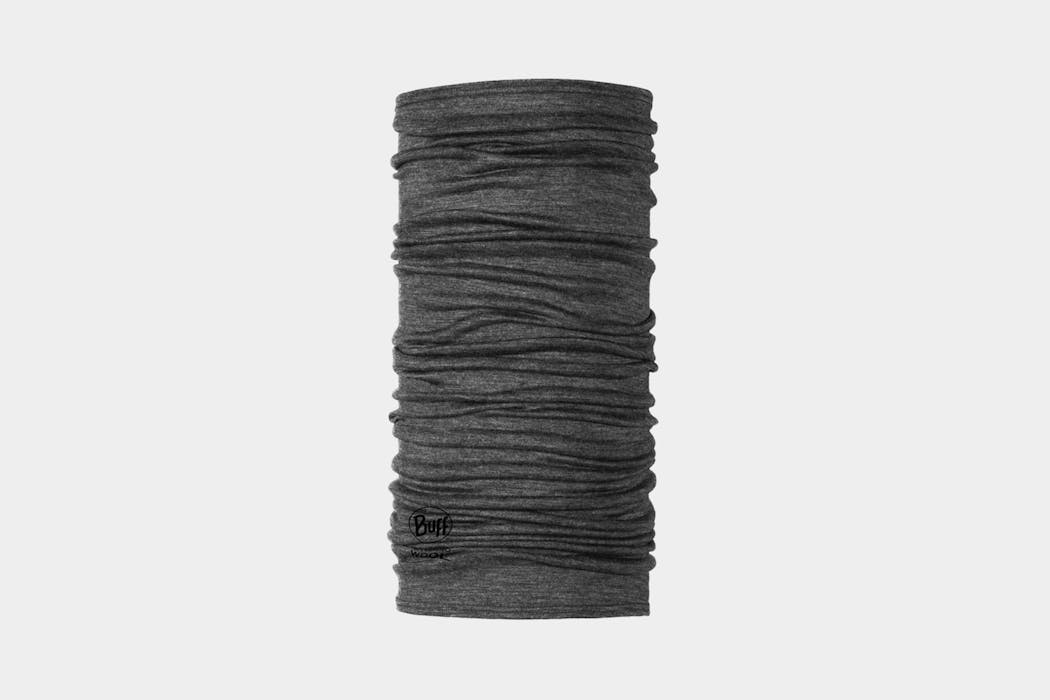
Versatile pieces can also go a long way when traveling. We love items that can be worn multiple ways, like Buff USA’s Wool Buff, which can be worn in twelve different ways. It combines a hat, face mask, scarf, bandana, balaclava and more into one tiny item—saving you space, weight and money.
Solid colors also can play a big role in versatility. You can generally piece together lots of solid color items and keep things interchangeable, meaning you’ll end up with more outfits for your trip without actually having to buy more tops and bottoms. We’ve also found that darker color pieces can help fight against stains and general wear and tear on the road. Accidentally spill some wine on your shirt while indulging in a pre-dinner amuse bouche in Rome? It happens to the best of us, really. But don’t worry, that black shirt won’t even show it and you’ll be good to go for the rest of your trip.
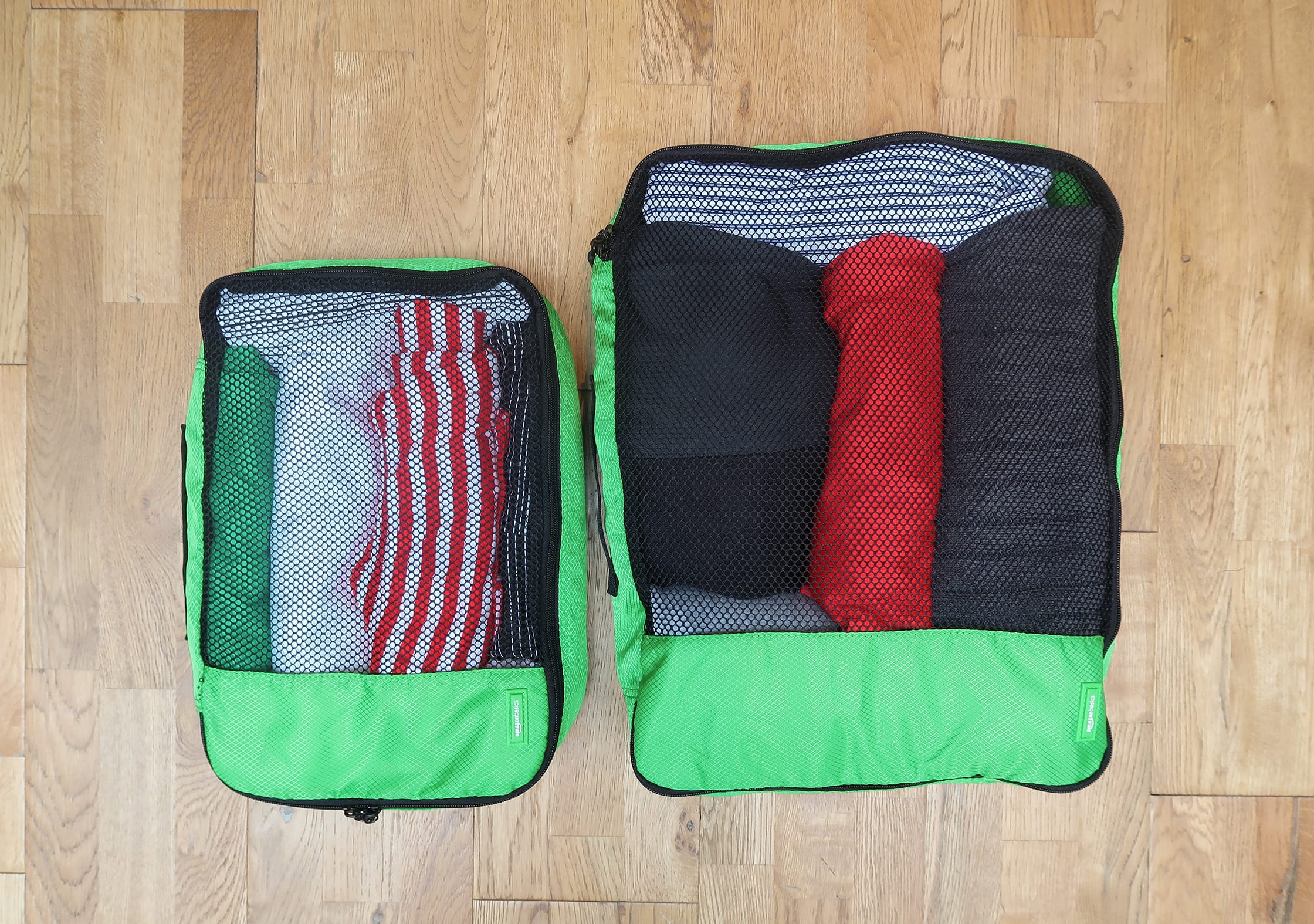
As long as you have tops, bottoms, underwear, and socks—you’ll be covered! (Unless you have some other body parts that we don’t know about?) Our advice here is to consider your length of stay, the climate(s) you will be enduring, the reasons for your trip (a wedding perhaps?), and cultural considerations depending on the location you travel to. For more on these, read on.
Shoes
Shoes can be a tricky item when packing. The key here, again, is versatility! Neutral colors like black and brown tend to work best with a wide range of outfits, so we like to stick with those. Darker colors will pick up less dirt and help keep your shoes looking good.
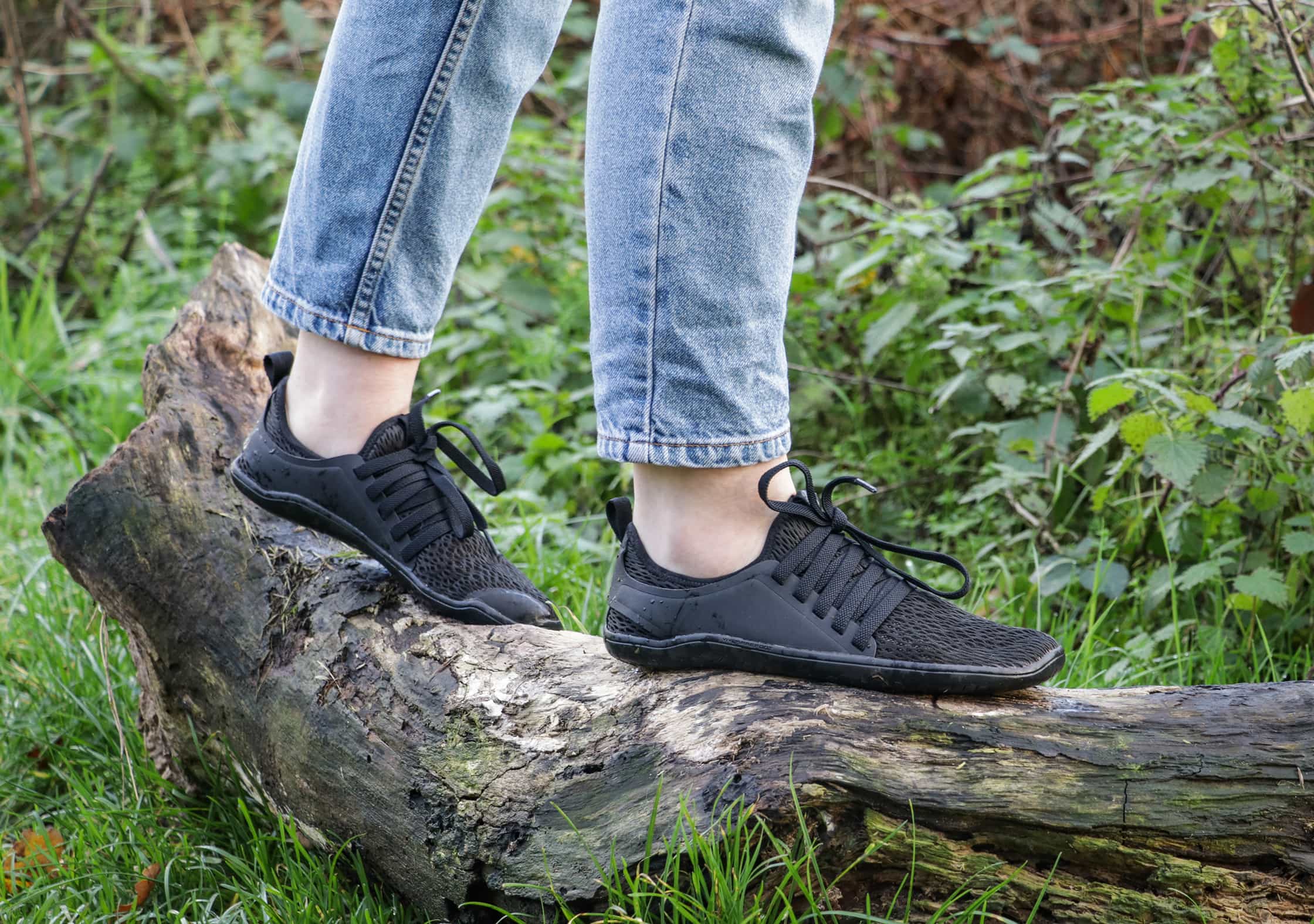
You are most likely going to want one reliable pair of shoes that you can walk comfortably in for long periods of time without feeling like your heels are beginning to bruise on day two of your trip. In general, if they have some padding, breathability, and they’re lightweight, they’ll probably be winners. Extra brownie points if they are packable! We’ve seen some pretty packable shoes in our day (we’re looking at you, Vivobarefoot Kannas).
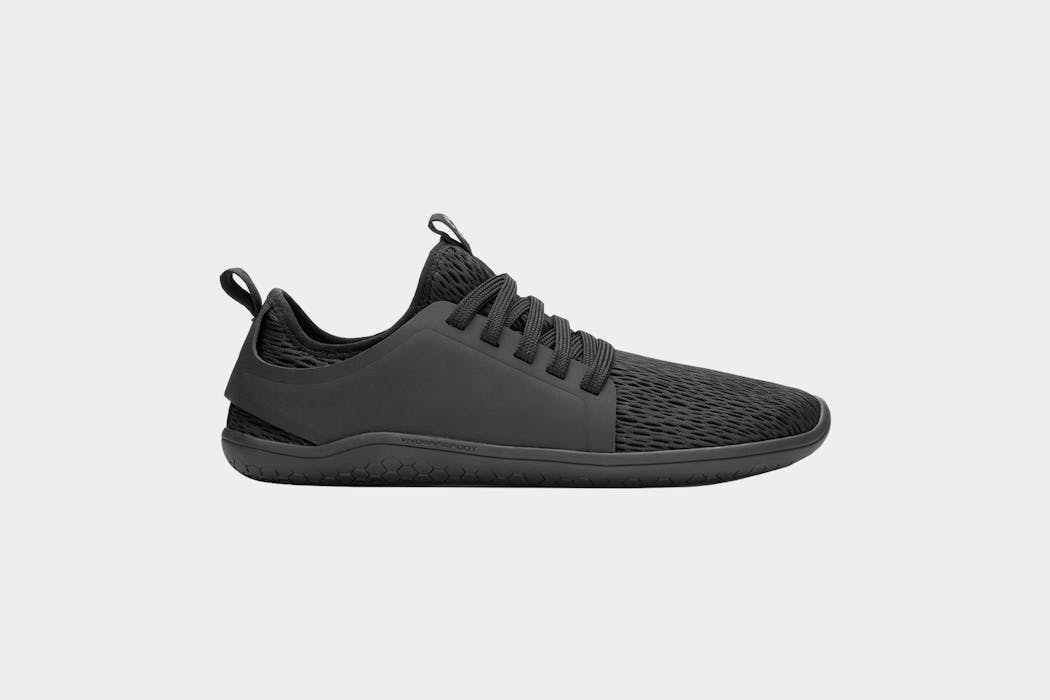
For such a lightweight pair of shoes, the Vivobarefoot Kannas are remarkably comfortable and we’ve been impressed with their versatility and packability. While the craftsmanship isn’t the best we’ve seen, they offer a superb option for any one-bag traveler looking for a pair of shoes that won’t take up half their pack.
We should also note that while having versatile and/or packable shoes is great, you shouldn’t feel restricted from bringing a nice pair of shoes or boots. We recommend wearing your bulkiest pair of shoes while in transit, so they don’t take up a ton of space in your luggage. If you go this route, just consider the length of your journey and whether you’re comfortable wearing those particular shoes for the duration.
Some backpacks offer a shoe compartment, which is pretty nifty for packing multiple shoes. We also love shoe compartments because you can toss in a pair of dirty shoes without mucking up the contents of your bag. In fact, it doesn’t even have to be shoes—these tend to be great compartments for wet clothes or other items you’d rather not have contaminate the rest of your stuff.
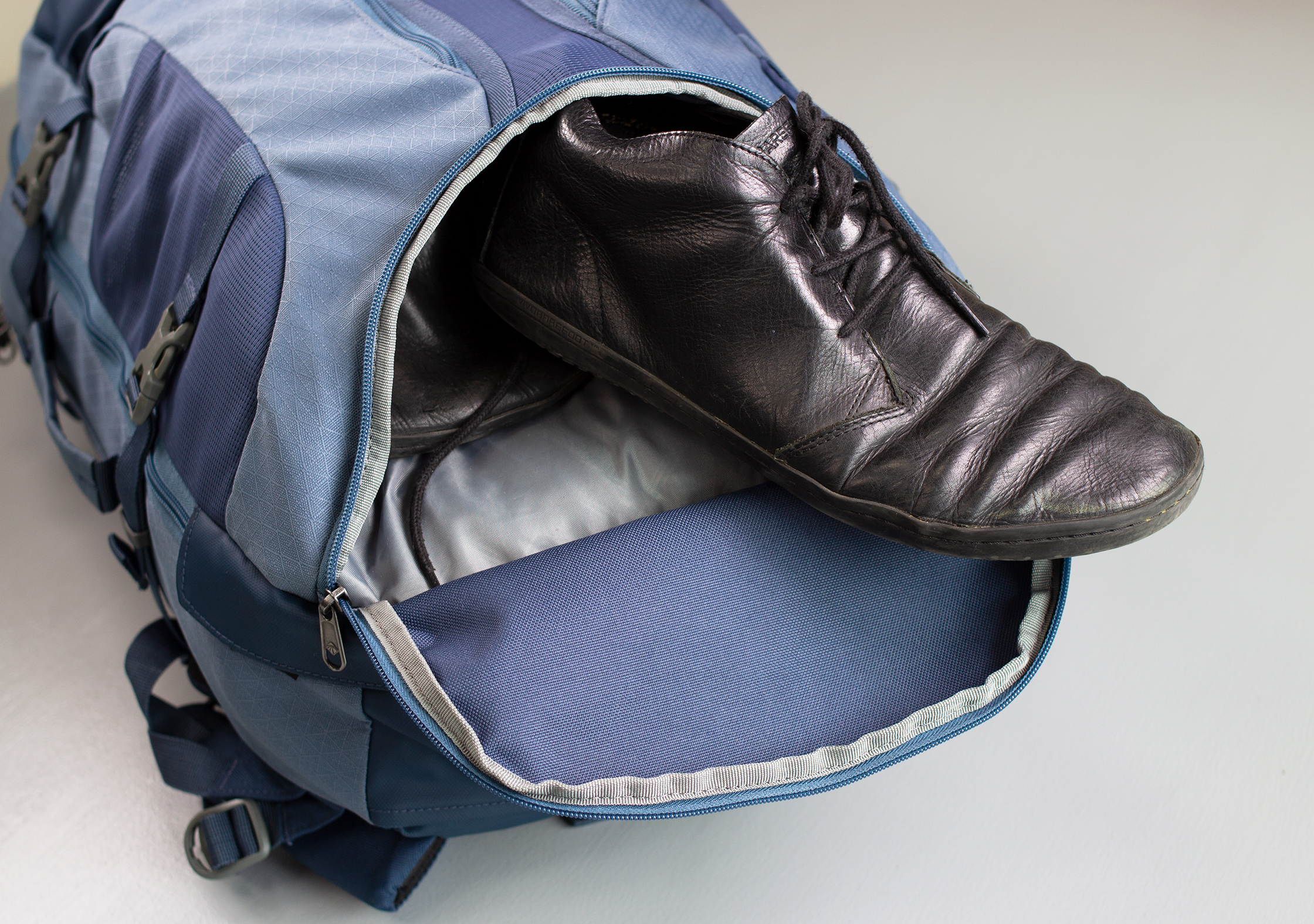
But while nice to have in certain scenarios, shoe compartments generally take away space from the main compartment of your pack, which can really screw up the configuration of your packing cubes/items. We recommend testing this out on your fully-packed bag before you leave to make sure that everything will still fit correctly if you toss your dirty shoes into the compartment.
If your pack or suitcase doesn’t offer this, you can always grab a separate shoe pouch, which functions just like a packing cube, except it’s made specifically for shoes (duh) so it’ll fit them nicely and offer a little thicker fabric.
At the end of the day, shoot for versatile, dark shoes whenever possible. If you’d like to bring multiple shoes, don’t sweat it—just wear your bulkiest pair on the plane. And if you anticipate dealing with some messy shoes, a shoe compartment or shoe pouch can be a lifesaver.
Toiletries
We already mentioned how useful a Dopp kit (AKA toiletry bag) can be, but we didn’t tell you how to pack it. Let’s dive into the details.
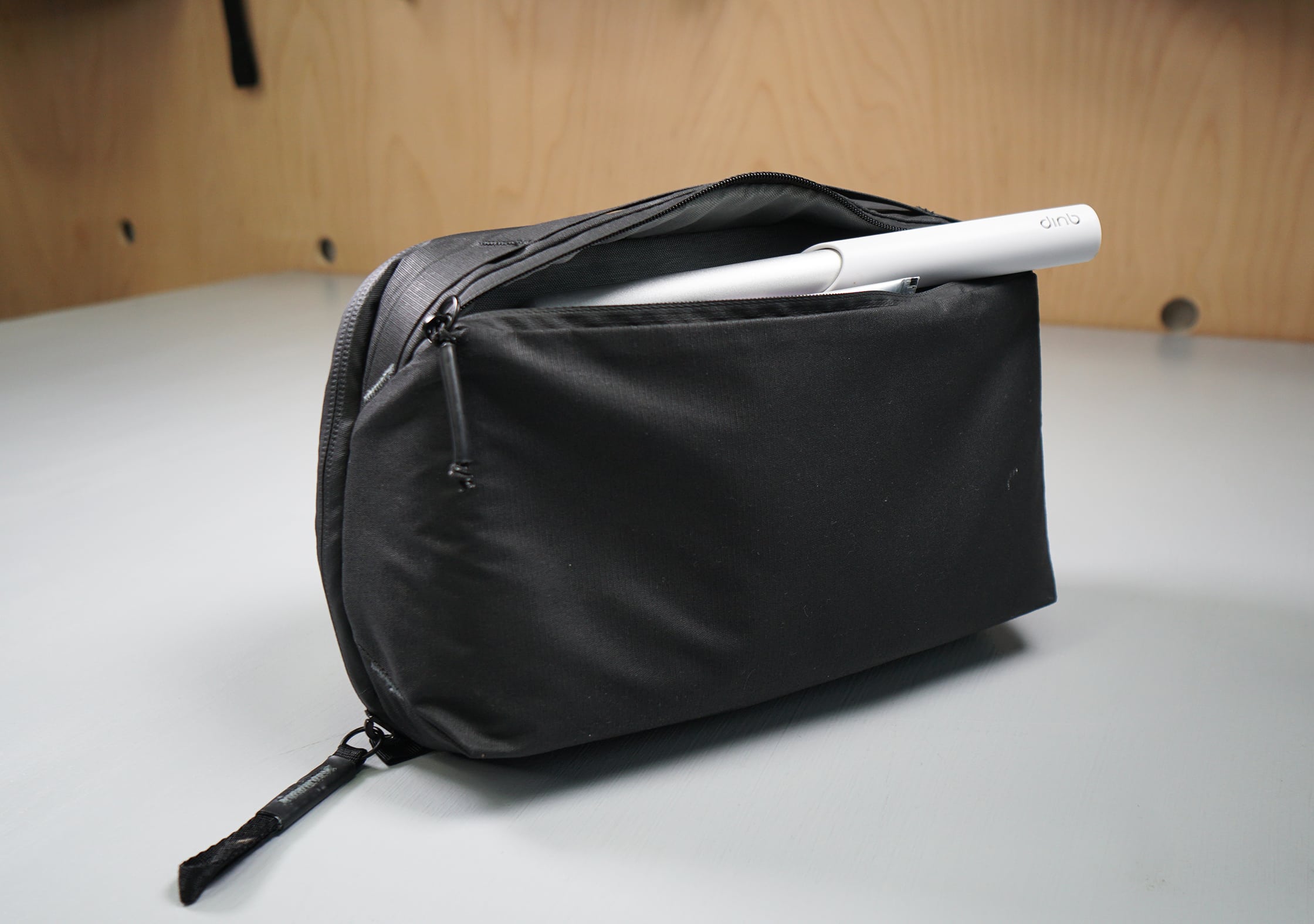
First things first, you need a toothbrush. Just about everyone travels with one (at least, we really hope everyone does). Most toothbrushes take up a similar amount of space and there are smaller, compact versions available that take up a bit less—but they’re kind of a pain to use. We have met some people who cut their toothbrush down to allow for just enough room to hold onto while brushing, or even people who will drill holes in their toothbrush handle to save weight.
If you are bringing along a toothbrush then you’re going to need some toothpaste or solid toothpaste tabs. As good oral hygiene goes, a small container of dental floss will also go a long way. If you’re seriously committed to saving space and/or weight, a spool of dental floss wrapped with a rubber band might be a good option.
Now, as much as we like having this stuff with us at all times, there is something to be said for grabbing these items once you reach your destination. We find that many travelers seem to forget that there are shops—just like the ones you have at home—at virtually any urban destination around the world. You can always buy toothbrushes, toothpaste, and floss after you arrive. Plus, if you’re staying at a nice hotel or Airbnb, they may offer this stuff for free.
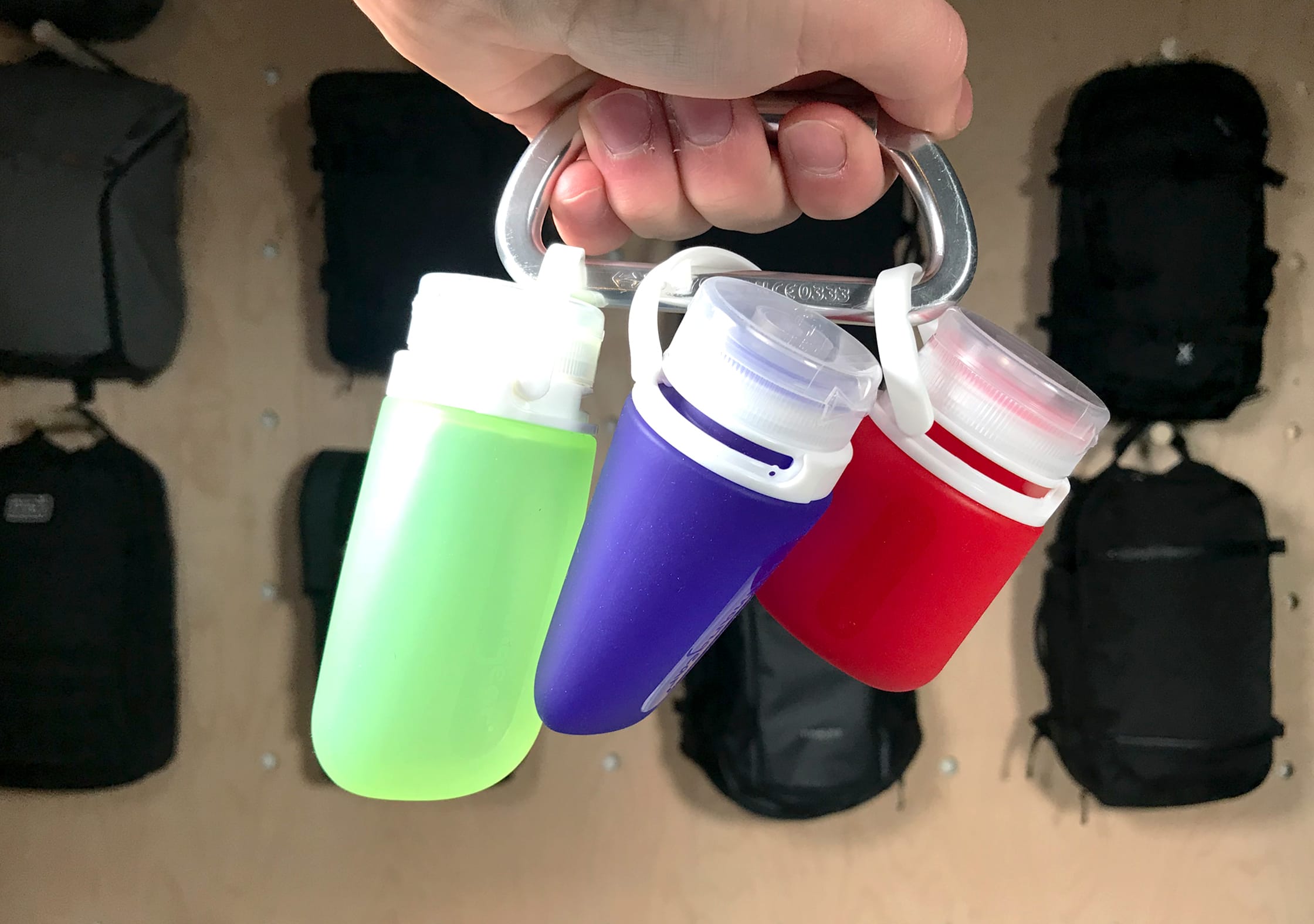
As far as storing things like shampoos, conditioners and other necessities, these can be squeezed into travel bottles or purchased in solid form. We are big fans of solid shampoo and soap bars because they last way longer than your average liquid alternative and they won’t eat into your TSA liquid quota. Plus, a good soap bar can be used for your hair, body, clothes, and even dishes. (Remember when we talked about versatility?)
A good thing to keep in mind here is the TSA’s 3-1-1 security rule for flying with carry-on liquids. This rule may differ from country to country, but in most major countries—and definitely the U.S.—it means each passenger can bring aboard a one-quart plastic bag with 3.4 ounce/100ml bottles of liquids inside it. You can take as many bottles as you want, as long as they’re all under 3.4 ounces and fit inside that plastic bag. So, needless to say, solid items are a great choice. Plus, you’ll never have to worry about a soap bar exploding in your backpack.
We should note that this rule is only for carry-on bags. You are allowed to put liquids of any size in checked bags. And if you’re halfway through security and realize you have too many liquids, you’ll either be forced to throw them out or check your bag.
If you have long hair, you’ll probably want to pack a compact hairbrush or comb in your Dopp kit. (We’re big fans of the Tangle Teezer Compact Styler, which might just be one of the most compact hair tools on the market.) That being said, this is another item that can be found at most convenience stores after you arrive at your destination.
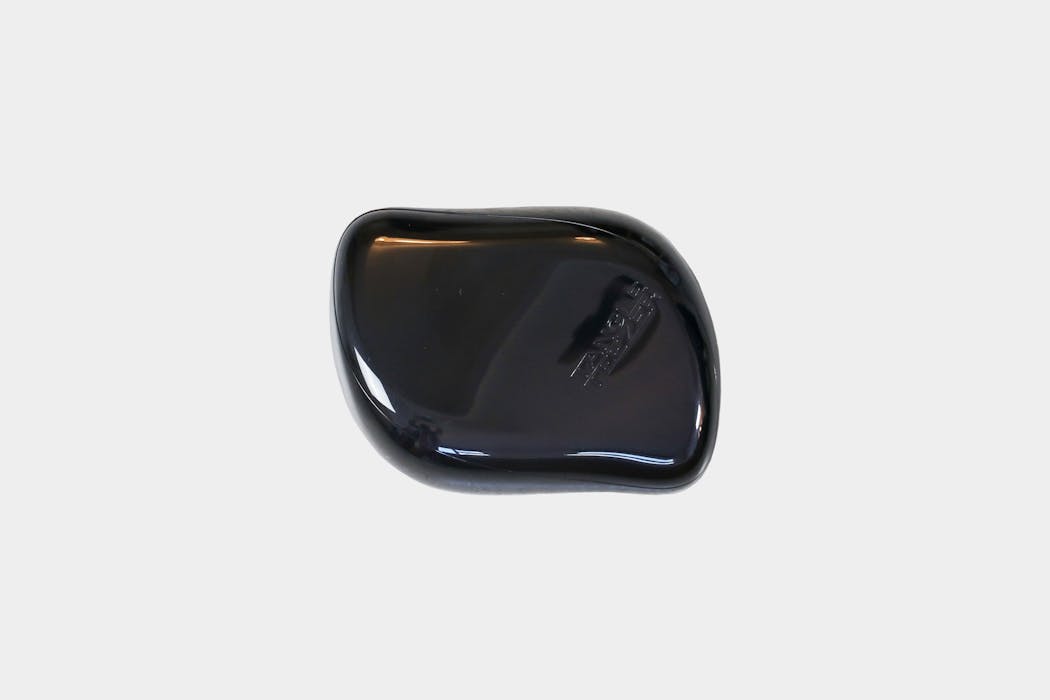
If you’re looking for a hairbrush that won’t damage your hair, saves you time, and fits inside your dopp kit, the Tangle Teezer Compact Styler is a fantastic choice. Other than some minor aesthetic blemishes after five years of testing, this is a great brush that will last you for years to come.
Deodorant will help you stay fresh, which is (obviously) important on the road. It’s pretty hard to make friends when you stink to high heaven. Many of these come in small travel sizes or small tubes. We even know some folks who will cut out a small stick of deodorant and fill up a chapstick tube to save weight, but that’s a little overkill unless you’re really trying to go ultralight.
One thing to note is that if you are packing merino wool, you should stay away from deodorants with antiperspirants in them. We also suggest clear or colorless deodorants as we’ve seen color build up on some of our lighter pieces of clothing after a number of washes.
Some other items to consider packing in your Dopp kit are:
- Nail clippers: This may fleet your mind at first, but when your nails start growing without notice or a hangnail develops, you’ll thank us.
- Makeup: Try to keep this as minimal as possible. You likely won’t need your large make-up brushes or entire eyeshadow pallet.
- Q-tips: Compact, lightweight, and useful in certain scenarios. There are the obvious uses—like cleaning your ears—and the not so obvious—like makeup removal and cleaning out small ports on electronics.
- Razor: If you’re looking to keep a clean shave on the road, make sure to bring a travel-friendly razor with you—AKA, not a safety razor! Those will get taken by security.
- Trimmer: If you’d like to keep your beard in check or you’re more into the scruffy looks, travel-friendly trimmers do exist!
- Sunscreen: Depending on where you’re going (and your complexion), this may be a necessary addition to your Dopp kit. Let us be the first to tell you—holding a backpack with a sunburnt shoulder is NOT ideal.
- Lotion: In the chance you get a sunburn, this will come in handy. In the chance you just have dry skin, this will also come in handy. Long story short, it will come in handy.
- Contact Lenses: If you do wear contacts, we’d highly recommend picking up a small case and a travel-sized solution bottle to save a bunch of space. DO NOT put contact solution into a travel liquid container! That stuff needs to be sterile or you’ll risk an eye infection, so keep it in the original bottle.
- First Aid Kit: “I really wish I didn’t have that First Aid Kit,” said no one, ever. This should be self-explanatory. And before you ask, yes—it is worth the weight and space.
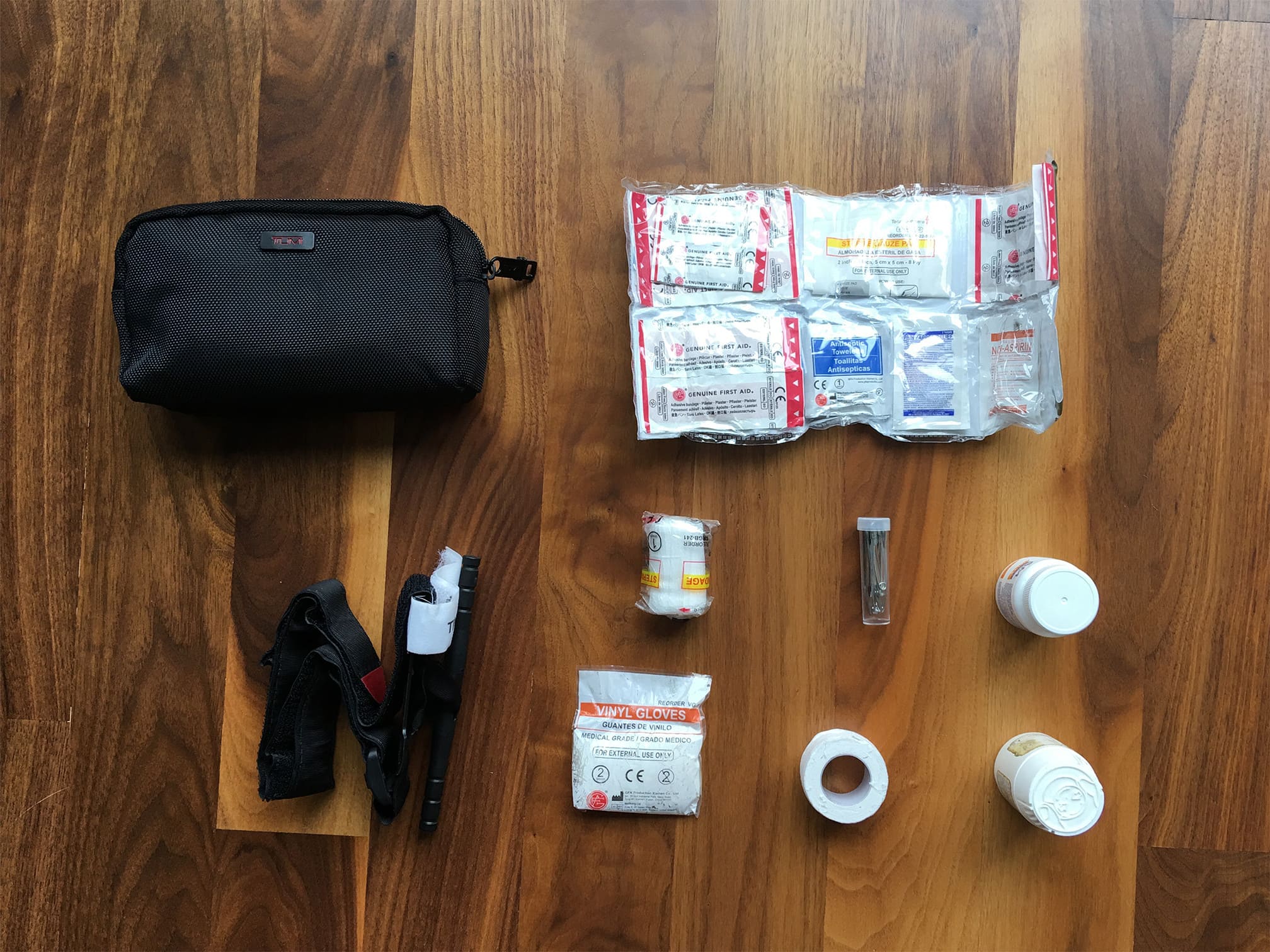
Duration
The amount of time you are traveling for may change what you bring along…but you’d also be surprised. For example, one merino wool t-shirt can be enough for a weekend trip to California, but even if you’re traveling perpetually you’ll only need three or four merino t-shirts. It all depends on how minimalist you’re ready to be, and the quality of items you choose to travel with.
If you’re planning a weekend trip, you can pack super light. But the point we’re trying to make here is that, even if you’re traveling the world for a year, you can still pack pretty damn light. Three to four outfits, an outer layer, tech gear, and toiletries is more or less all you need. (This is the minimum, we’ll get into some other nice-to-have stuff below.)
Climate
The climates you plan to travel through may skew your essential packing list items. For example, if you plan to be traveling around South East Asia for a month, you are going to want thin, breathable clothing items. On the other hand, if you are planning for two weeks in Canada, heavier clothing will be your best friend. If you are a last minute spontaneous traveler (we like your style), you’ll want to prepare for a range of climates.
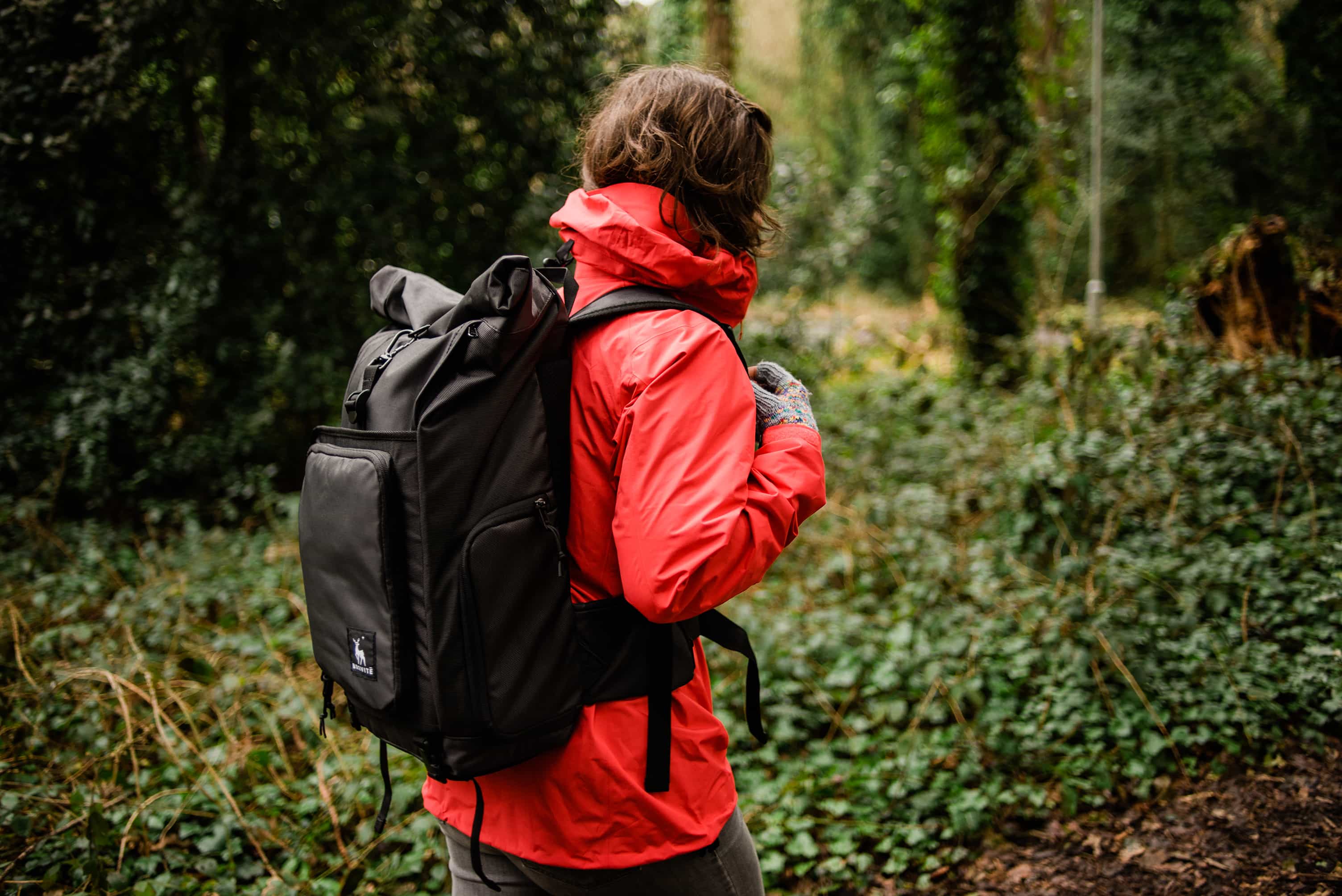
Outside of the desert, rain can happen just about anywhere. Make sure to grab a rain jacket, and if you can, go for a packable option—they take up barely any space and work just as well. That way, you are prepared for whatever the weather may bring. If you are headed somewhere that is heavily prone to rain—we’re looking at you, South East Asia in July—we highly recommend staying away from cotton clothing as well, as it tends to soak up more water and dry slower than other materials.
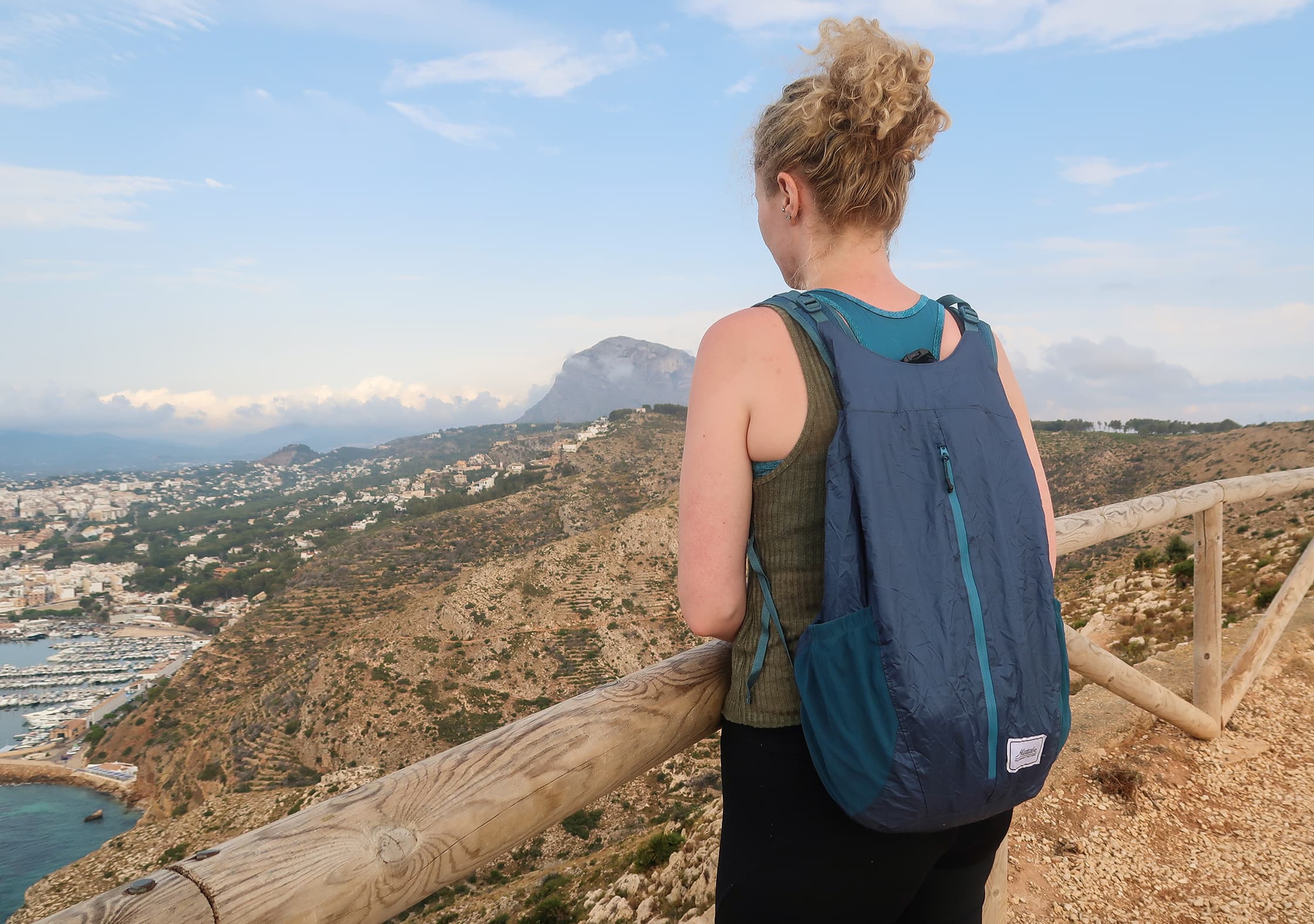
If you’re heading to the beach, don’t forget your swimsuit! This is explanatory, but the real key to packing for the beach is (again) versatile clothing. There are a handful of men’s swimsuits that look like totally normal shorts, so you can wear them to the beach and the bar without anyone noticing. (You really should rinse and dry them in between, though.)
There are also many options for women, including tops that double as crop tops and one-pieces that double as bodysuits. Grab a swimsuit that is more versatile to avoid overpacking and get the most out of your apparel choices!
Shoes are another climate consideration. If you are heading somewhere sandy you may want sandals, which allow you to flip-flop through the sand without creating a small beachfront ecosystem inside your shoes.
For humid areas, you’ll want to look into some breathable, possibly mesh, shoes. And for rainy climates we think you can go one of two routes—either go waterproof and bulky (wear them on the plane to save space in your pack!) or lightweight and open. You’ll either want to avoid getting your feet wet entirely or just relish in the wrinkly toes and go for a pair of shoes that will dry quickly at your hotel or Airbnb.
And finally, cold climates don’t necessarily mean heavy winter boots. We love merino wool shoes because they’re warmer—and a hell of a lot lighter—than your average pair of sneaks.
The stuff you don't need to have, but kind of want to have.
With gear for any traveler or adventurer, you can find something for everyone on your gift list. Check it out →
What to Consider for Your Packing List
In addition to your basic packing essentials, there are also some nice-to-have items that you may want to think about bringing. These will likely depend on the type of travel you are packing up for—for example, the digital nomad life requires a different set of items than a family vacation in Florida, honeymooning in the Maldives, or summer in Europe.
Tech Accessories
As seasoned digital nomads, we know how important packing tech accessories for the road is. Without our tech gear, we would find ourselves unpaid, unemployed, and well…broke. And since no money = no traveling, it’s kind of a big deal.
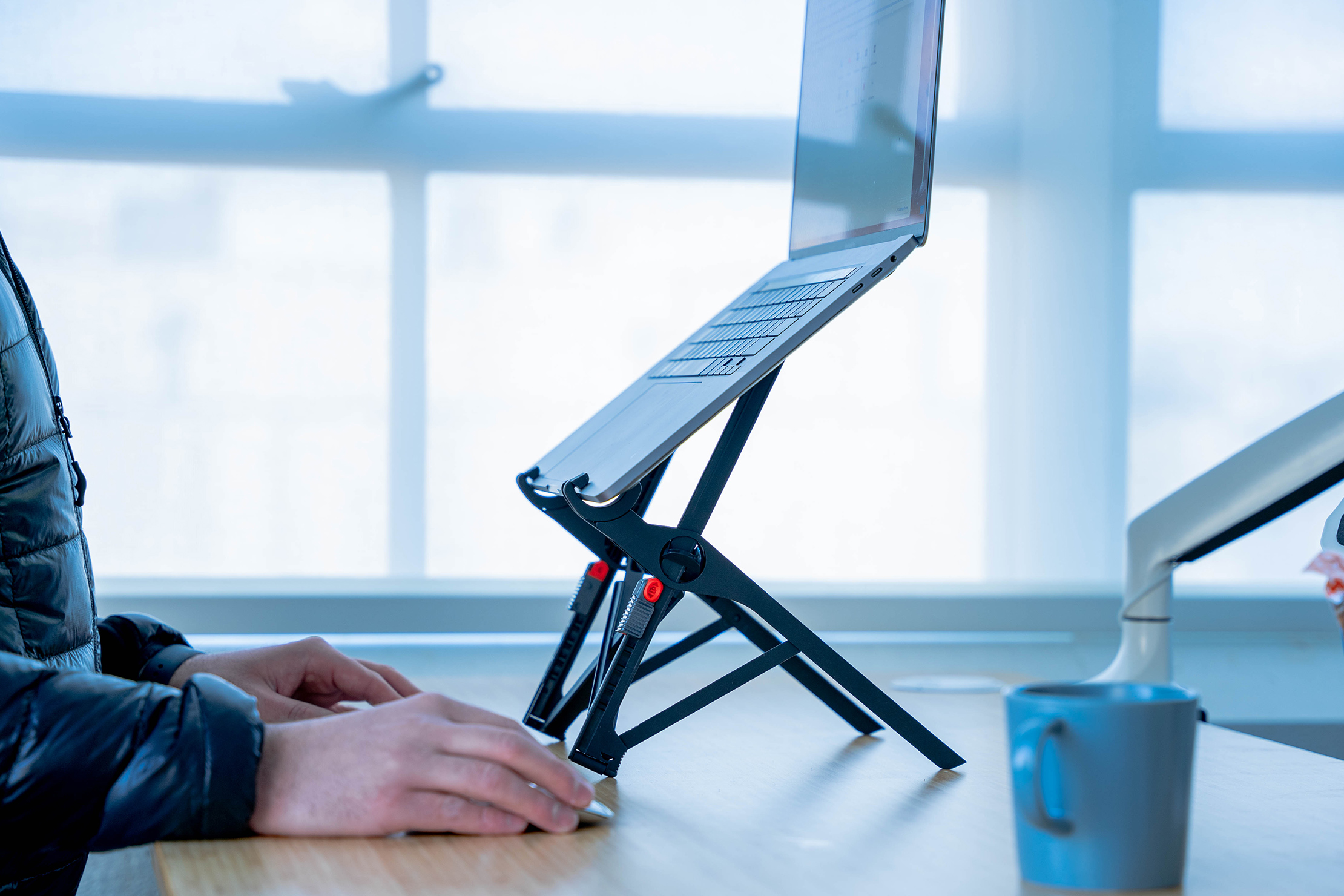
First and foremost, you are going to want to bring along your laptop. If you plan to get the majority of your work done with it, this is essential. We’re not going to dive into laptop recommendations, but we will say that any digital nomad should seriously consider buying a pack or suitcase with a nice laptop compartment. You want something that will offer support, security, and ease of access.
And even though most laptop compartments have some form of padding, we always recommend grabbing a protective laptop sleeve. Chances are, your laptop is your livelihood—so you want to keep it as well-protected as possible.
If you do plan to be at your laptop for a considerable amount of time, we recommend checking out an ergonomic portable laptop stand. (We are more or less in love with our Roost Stand, just saying.) These little stands can quite literally save your back, and after getting used to ours, we’re never looking back. In addition to being beneficial for your health, most portable laptop stands can stow away in a compact manner without adding a ton of extra weight.
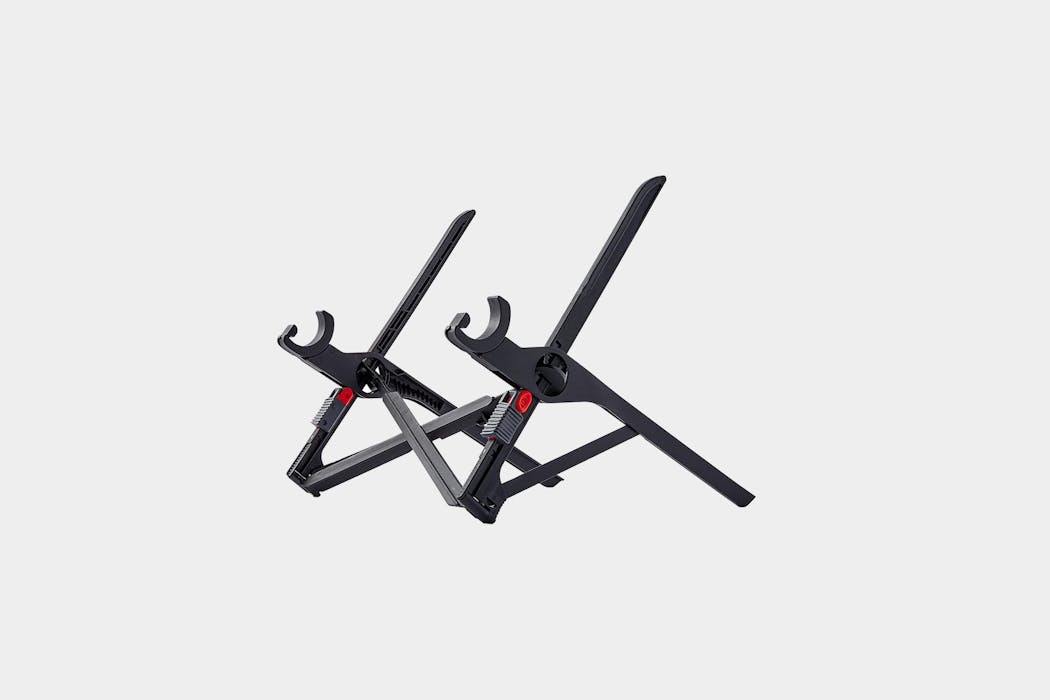
We took an in-depth look at the Roost V3 Laptop Stand, an original portable laptop stands for digital nomads and one bag travelers that work on the road.
If you plan to bring one of these along, you also won’t want to forget a small portable keyboard and mouse. We prefer Bluetooth for these accessories—because, let’s be honest, wires suck—but you may want to factor in your destination before you decide on this. While Bluetooth is convenient, there are a lot more things that can go wrong. If you’re headed to a remote destination, you may want to opt for wired accessories. If it’s super remote, you may even want to bring some redundancies—like extra cables, chargers, etc.
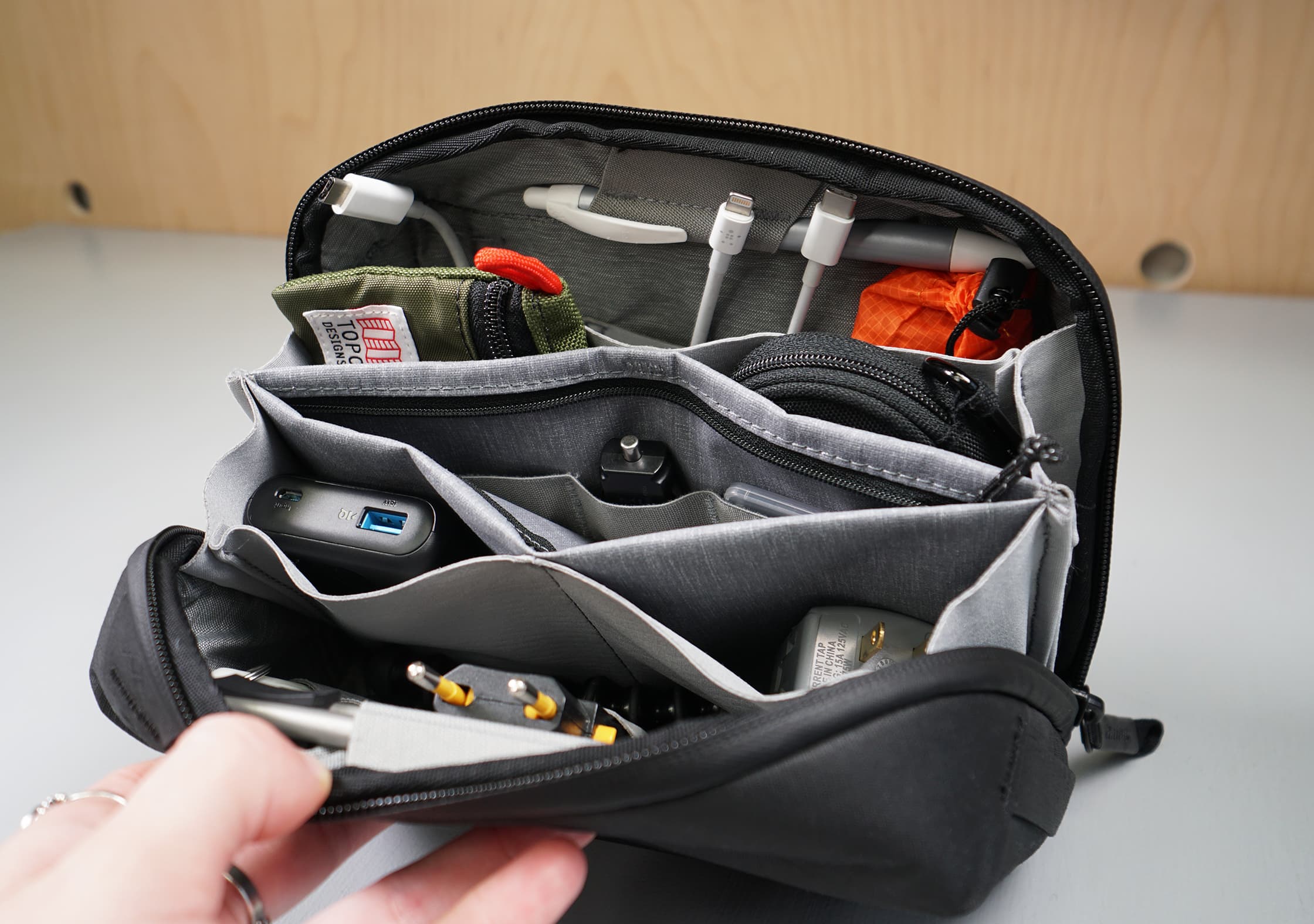
You already know to bring your chargers and charging cables, but you can really take this to the next level by grabbing a multi-port USB charger, outlet splitter, and universal outlet adapter. That way, you can charge multiple items at once and you’ll be good to go in any country you venture into.
We should also mention that, although you probably can buy some of these things at your destination, we’d recommend against it. When it comes to tech gear, you’re almost always better off buying high-quality components far in advance. That way, you know you’re getting the best deal and the best stuff. Buying charging cables at the airport or touristy areas is a recipe for disaster. Not only will they cost an arm and a leg, but they might not even make it through your trip.
Any digital nomad should, of course, pack a pair of headphones along with their tech gear. Earbuds are great because they save space and weight, but you’ll compromise on sound quality and noise-canceling. This is mainly up to personal preference, but our one major recommendation would be to grab some headphones that have a microphone built in. That way, you can use them to talk on the phone while keeping both hands free.
If you plan on country hopping or being on-the-go often, we highly suggest grabbing a battery bank. This little tech accessory will save your sanity when your phone battery is at 5% and you’re frantically trying to find your Airbnb as the sun sets in Barcelona. It might sound romantic at first, but walking around in the dark with no clue where you’re going isn’t the best situation to be in. Save yourself by grabbing a small battery bank—we love the selection from Anker.
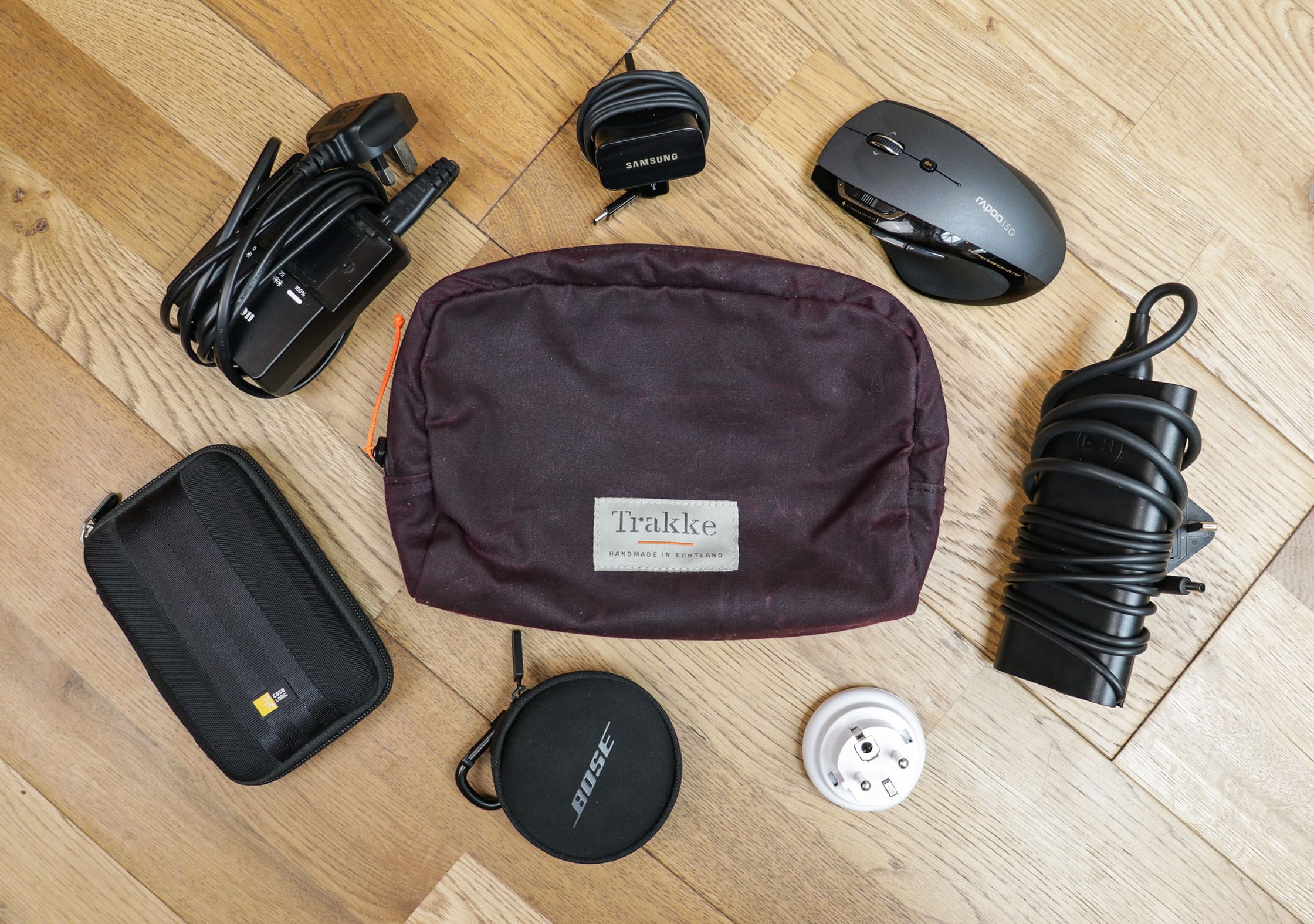
Just make sure that yours is under 100Wh (watt-hours)! Due to TSA restrictions, you’re not going to be able to carry any bank over 100Wh on to a plane, although you may be able to bring larger ones on with approval.
This typically means you can use any bank that is under 27,027 mAh (milliamp hours) without approval from your airline. If you have a bank over that—and under 43,243 mAh—you’ll want to contact your airline and get it approved beforehand. And just to make things more confusing, you should know that these numbers are assuming your bank is at the standard voltage of 3.7V. If it’s a different voltage, they will be skewed.
Confused? Most portable battery banks are going to be just fine. Make sure to check the watt-hours on the website before you buy and you’ll be good to go. And if you’re really confused, drop us an email and we’ll check it out for you!
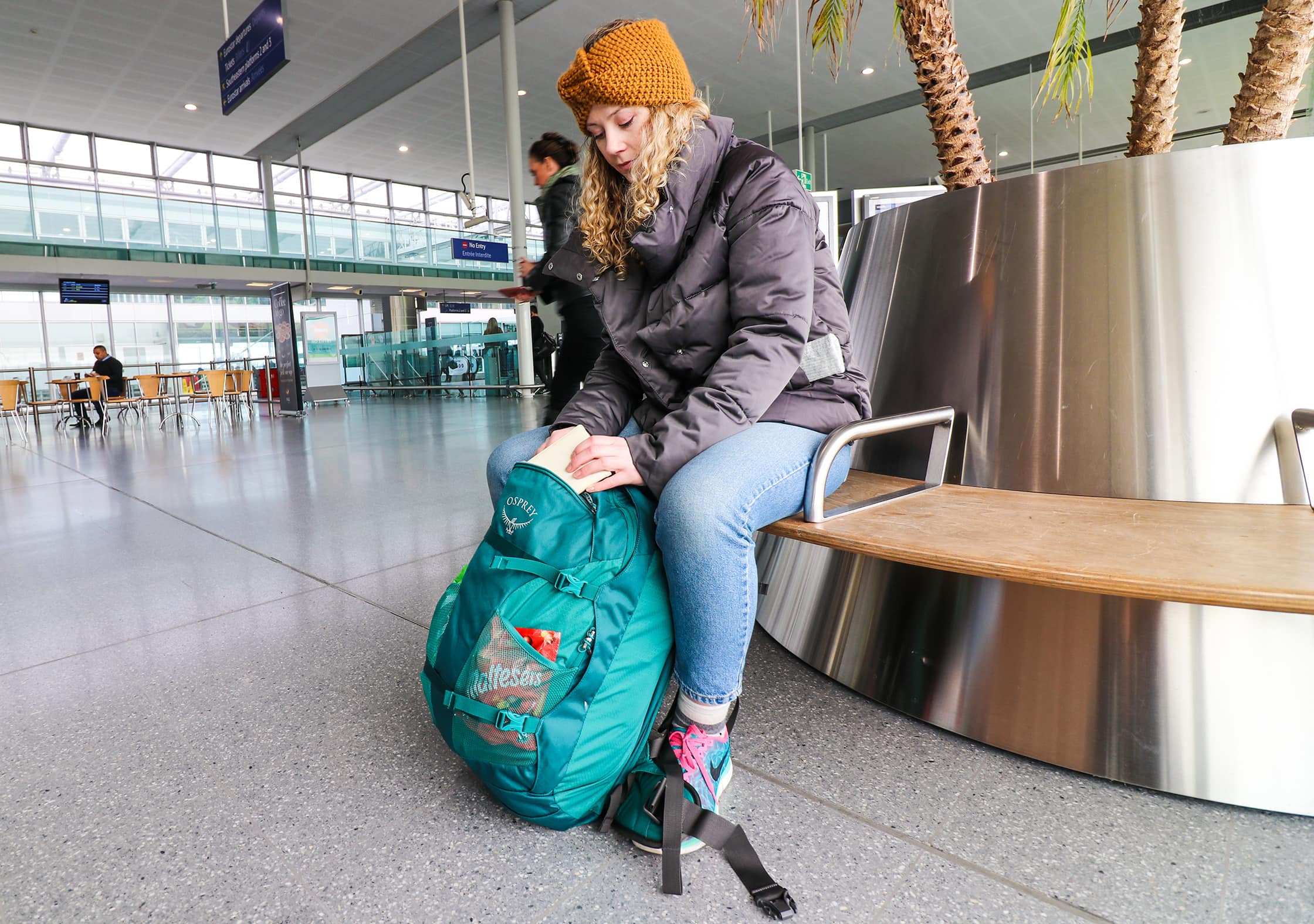
We don’t need to tell you this, but we will anyway—pack your phone. Besides functioning as a GPS, watch, weather portal and entertainment center, we typically get a lot of mileage out of our smartphone cameras during travel. Some people might want to bring a dedicated travel camera—which is fine—but in most scenarios, a smartphone camera can get the job done while saving a whole lot of space.
And speaking of phones, we’d suggest downloading a couple essential apps:
- Skyscanner is great for booking last minute flights on the cheap.
- Hopper is great for finding the right time to buy plane tickets in advance.
- HotelTonight is good for finding cheap, last minute hotel rooms.
- Kayak is one of our favorite options for finding accommodations and transportation.
- Airbnb is probably our favorite accommodations app, and if you’re not already on the Airbnb train—you should be.
- Google Translate is a handy app for getting across language barriers in a pinch. Although, as good as it is, it won’t replace a human translator.
- Google Maps is great for navigating anywhere in the world and gives you the ability to download local maps for offline use.
- TripAdvisor has everything from restaurant reviews to flights to travel forums. An essential for any long-term traveler.
- FourSquare is a great option for finding coffee shops, restaurants, and more.
Packable Daypacks
Packable daypacks are, as the name implies, smaller backpacks that can compress or pack down to nearly nothing. We love these because they allow you to leave your larger bag at your Airbnb/hotel/hostel and explore your destination with just the gear you need for the day.
Packable daypacks come in many forms, but these are some of our favorites.
- Compressible Daypack: A packable backpack that can be compressed into a tiny little package when not in use. These are typically made of very thin and lightweight materials, and you compress them by stuffing them into a pocket or stuff sack. They’re a tad delicate, but that’s the tradeoff you get for ultra-compressibility. That being said, there is still a bit of a spectrum here, from ultralight to slightly more robust options.
- Packable Totes or Duffels: Kind of like the backpacks above, but a tote or duffel! Totes are good for a casual look or a trip to the grocery store, while the duffel format will typically be larger than what a packable backpack can offer.
- A Regular Daypack: Yeah, we’re kind of contradicting ourselves here, but a regular daypack can work in a pinch depending on how big your travel backpack or suitcase is. If you’ve got a small daypack, try laying it down in your main compartment or stuffing it into a laptop compartment. If it works, it works!
- A Regular Tote Bag: Let’s face it. You probably have a dozen or more random tote bags lying around that you don’t use. Grab the lightest, thinnest one and stuff it into your travel pack. You and your wallet will thank us.
- A Plastic Grocery Bag: This is tough for us to say, but here it goes. (Deep breaths.) In a worst case scenario, you can always stuff a…plastic grocery bag…in your luggage. This is really not the best solution for carrying your items around throughout your journey, but it “can” work. However, we will concede that a plastic bag is nice to have for containing dirty laundry, wet shoes, and other items you’d rather not have in contact with the rest of the stuff in your pack.

One major bonus to having a packable daypack in your travel arsenal is that you can also use it as a secondary vessel to carry stuff home that you didn’t plan on in the first place. Sometimes, your luggage seems to mysteriously expand during your trip, for whatever reason—whether its souvenirs, food, supplies, or just unorganized packing. Having an additional pack can give you some peace of mind, knowing that you’ve got plenty of room to bring home all that Swiss chocolate that your aunt has been begging you for.
We should also note that many one bag travel packs offer compression straps, allowing you to slim the pack down—sometimes substantially. If you get the right pack, you can easily leave some of your stuff at your Airbnb/hostel/hotel, slim your pack down, and head out for the day without having the extra bulk of a fully-laden pack. (Just make sure your belongings are secure, wherever you leave them!)
Workout/Health Items
Staying healthy while traveling can be tough, but we’ll give you some recommendations to make things easier. With just a bit of planning and a small amount of space, these items can help you feel good, boost your productivity, and create a morning—or evening—routine while on-the-go.
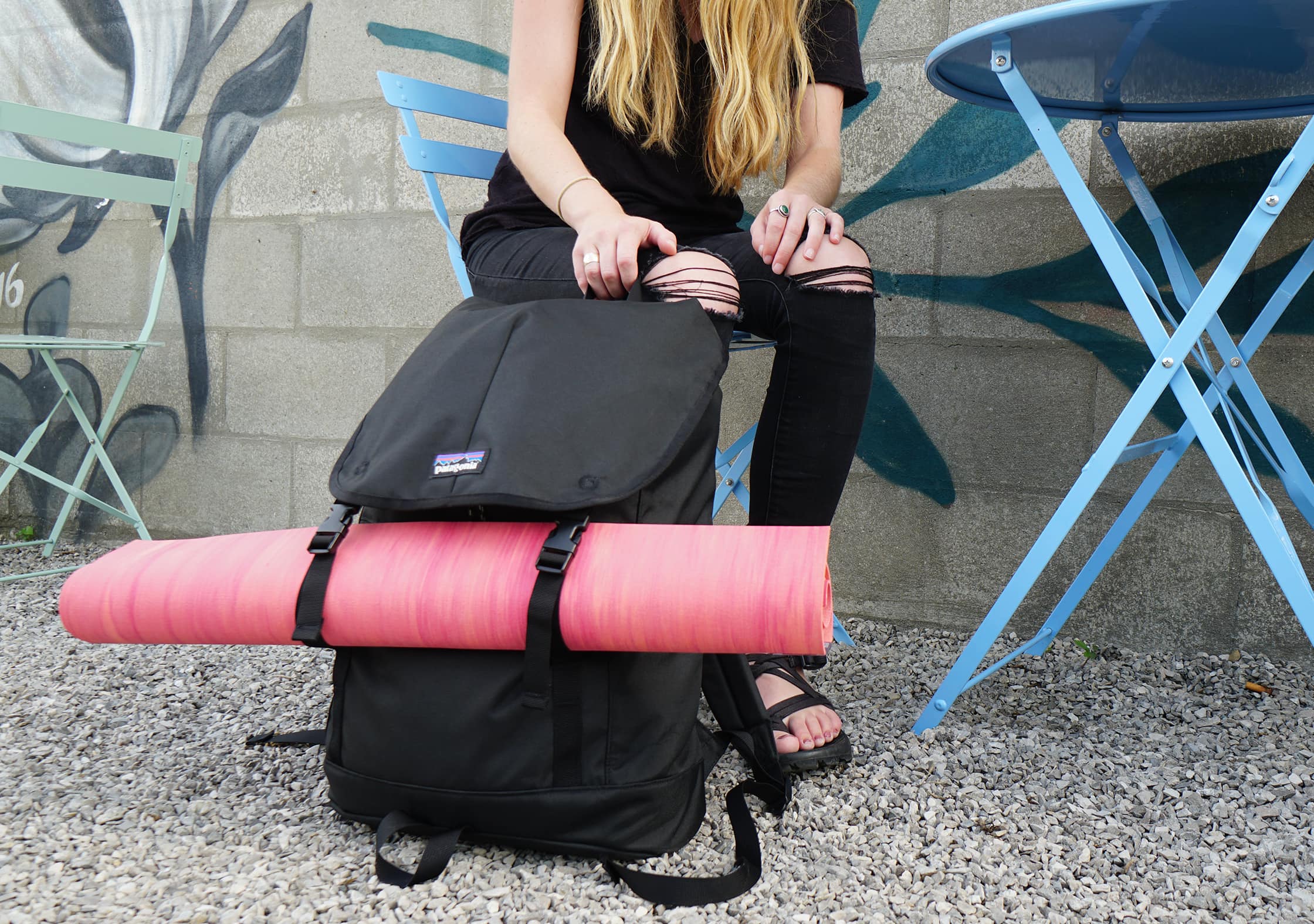
If you’re an avid yogi looking forward to sun salutations on-the-go or just hoping to have a reliable space to stretch each morning, a travel-friendly yoga mat should be an essential addition to your list. Many travel packs will offer some way to secure a yoga mat to the outside, so if you do this right, you won’t really be sacrificing any space in your pack. These mats can be multipurpose too, providing some space to lay down on the beach or even take a quick power nap at the airport.

Whether you’re an avid yogi or just looking for a spot to zen out while traveling, the Manduka eKO SuperLite Yoga Mat is an eco-friendly choice that can be packed up smaller than your average yoga mat.
If you don’t want to bring a yoga mat—or you just want to have an entire kit of fitness tools at your disposal resistance bands are another option to consider. These little bands can be used in a million different ways to exercise pretty much any part of your body. These also tend to be a pretty budget-friendly option, along with being lightweight and versatile.
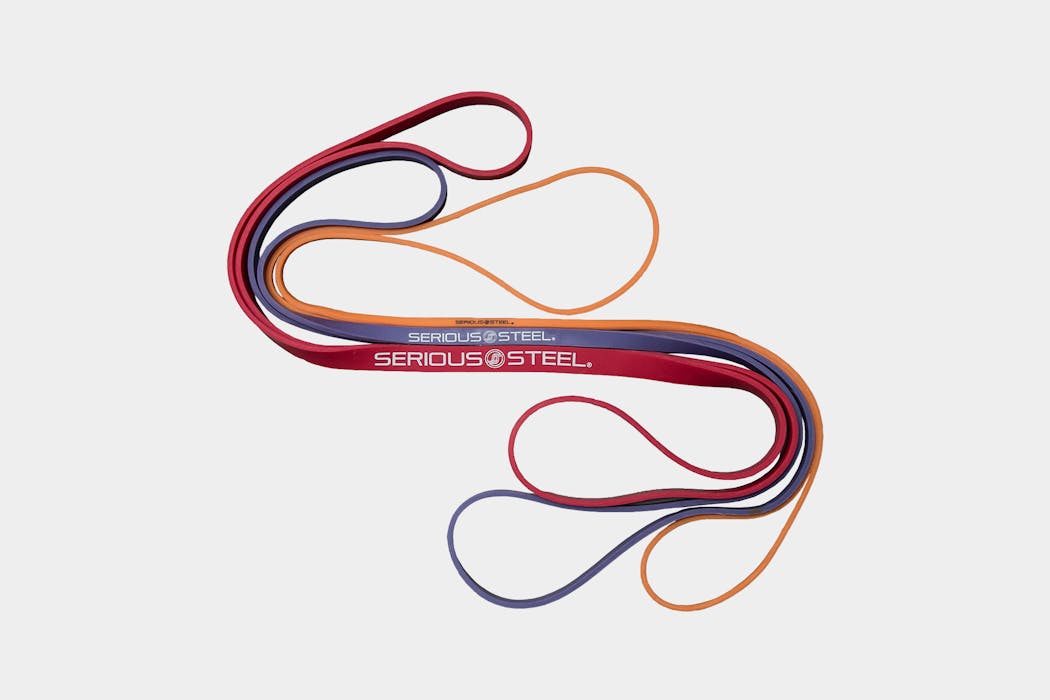
Serious Steel Resistance Bands offer a budget-friendly, lightweight, and versatile way to resistance train and stay in shape while traveling.
And finally, you could go for the most minimal fitness routine of them all—running! Just pack a pair of light running shoes and you’ll have everything you need to stay in shape across the globe.

Healthy snacks are also important! You never know what kind of food options you’ll encounter on your travels. Every now and then, you might find yourself in a situation where your options are limited, unhealthy, or you’re just not feeling the local cuisine. It’s worth grabbing some quality snacks, like protein bars and mixed nuts, at the supermarket before you leave. This step is highly recommended for vegans or vegetarians traveling to remote areas of the world. It can be tricky out there.
Speaking of snacks and foreign foods, if you tend to get stomach aches or you’re nervous about immersing yourself (and your stomach) into the local cuisine of a country you’ve never been to, you may want to consider picking up some charcoal tablets or another type of stomach soother. This is one of those situations where it’s better to be prepared. Trust us on this one.
And finally, staying healthy—as in, alive and disease-free—on the road should always be a top priority. If you are heading anywhere that feels remote, like parts of Africa, South America, Asia, or Australia, you’ll want to check in with the CDC or other local medical centers to make sure you’ve got all the proper vaccinations. Even just a trip to your local doctor will likely do the trick—they probably get people prepped for travel all the time, and if not, they’ll be able to point you in the right direction.
It’s important to do this well in advance, as certain countries will bar you from entering if you don’t have the proper vaccinations, and some of them either require time to take effect or have to be spaced out from one another. Malaria pills are also no joke—make sure you come prepared.
Cultural Considerations
Wherever you may be adventuring, we highly recommend looking into cultural considerations before blindly heading off to a country you are unfamiliar with. Tradition and values are very important to pretty much everyone around the world. If you’d like to be a kind citizen of the world—and you obviously should—we suggest keeping some of the following in mind in addition to doing some research of your own.
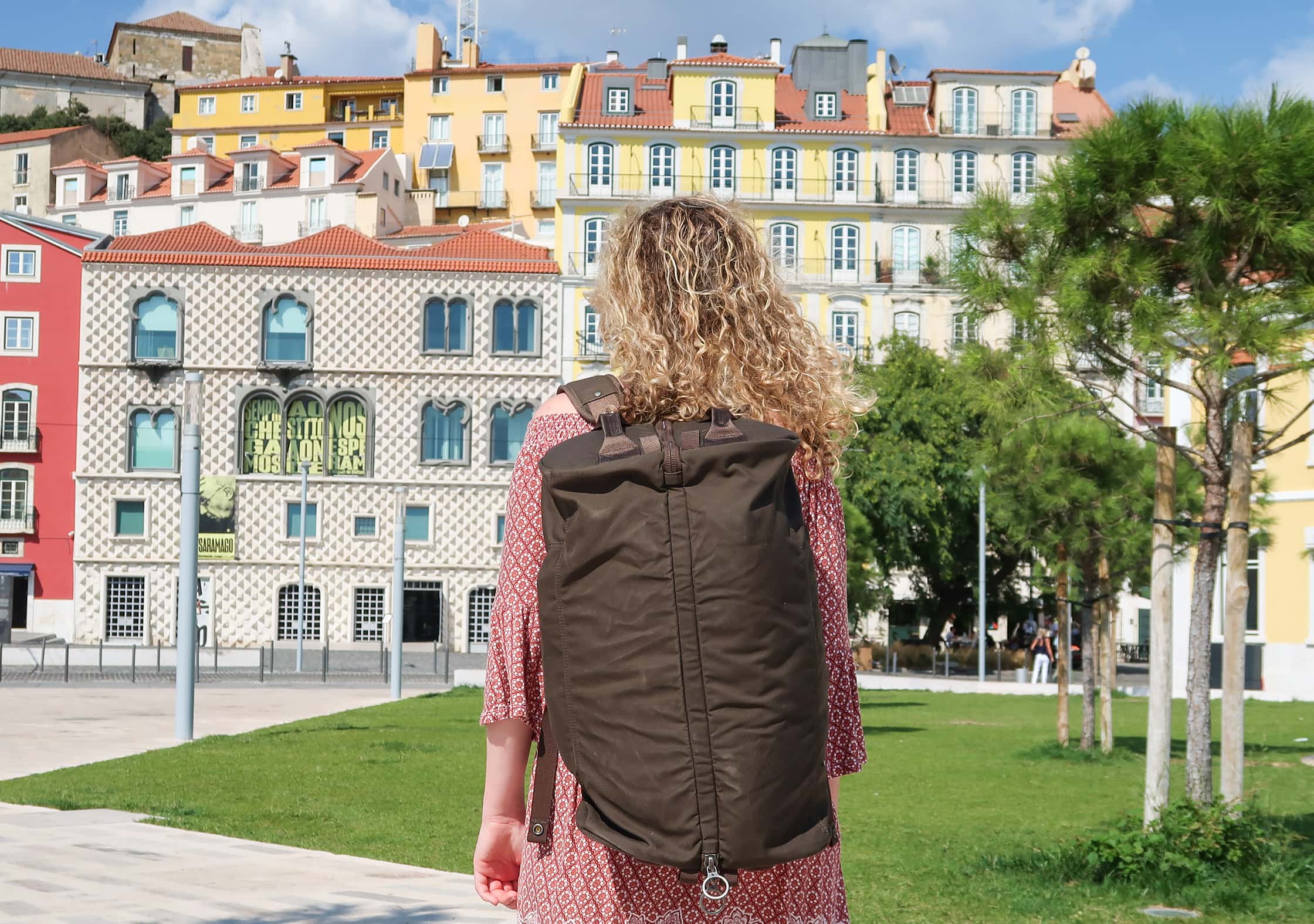
If you plan to visit some Buddhist Temples in Asia, be respectful of the dress code. You are expected to cover your arms and legs. A sarong can be great for this type of experience, and they’re sometimes even offered at the entrance of temples. In addition to the proper dress code, don’t be that person snapping photos at inappropriate times during ceremonies and rituals. Some things are better left as fond memories, rather than photo evidence. Be mindful of your surroundings.
Slip-on shoes are also highly beneficial in some areas of the world where you’re expected to take your shoes off frequently. In many parts of Asia, you’re expected to take your shoes off when visiting someone’s home or entering certain sacred areas. Slip-on shoes or sandals take up little room in your pack, but they’ll make your life a whole lot easier. (And spending 2 minutes to untie your shoes in these scenarios screams “TOURIST!”)
If you are traveling to China, consider packing less white pieces of clothing. We typically stay away from white clothing when traveling anyhow, as it tends to pick up lots of dirt. However, in China white represents mourning and is typically worn during funerals. Not a good look for your everyday attire.
When visiting select countries and cities in the Middle East, it would be frowned upon—and in some places illegal—to not be covered in a modest manner. Some places are more strict with these types of laws than others, so make sure to do your researc depending on your destination. In any case, it is a good idea to have a scarf with you to cover your head and shoulders if necessary for both respect and safety.
These are just a few of the most prominent cultural considerations we’ve encountered during our travels. It would be impossible to list out every consideration for every culture across the globe, so be sure to do your research before you hit the airport.
Travel Security
Traveling safely and securely is something that can be overlooked and undervalued—or overbearing and overdone, depending on how you do it! But we think it is absolutely worth considering. There is crime just about everywhere, and unfortunately, tourists tend to be easy targets. Especially when you’re living out of a single backpack, you need to keep your belongings safe. That pack is your lifeline.
Some backpacks and suitcases offer lockable zippers, allowing you to attach a small padlock to keep thieves at bay. Pacsafe is a great brand to check out for all your travel security hopes, wants, and needs. Other packs offer more subtle safety features, such as discreet lockable zippers, hidden pockets, and tear-proof materials. And in places where theft runs high, you may even consider grabbing some additional security gear.

We love simple security features, like hidden pockets on the back panels of backpacks. That way, you can store secure items like your passport and cash, knowing that it would be impossible for anyone to snatch them while you’re wearing the pack. Some packs also offer hidden pockets within the internal compartments that would be virtually impossible to find if you didn’t know what you were looking for
If your backpack does not offer much in the way of security features or if you’ve opted to travel with a suitcase; traveling with a small fanny pack or sling may be a great option to hold your valuables. With a sling or fanny pack, small items can stay close to you at all times—they are also a great spot to store your phone for quick access whenever you want to snap a quick photo on the road!
And finally, our last piece of travel security advice is to do whatever you can to make a potential thief’s life more difficult. The vast majority of thieves are looking for the easiest, quickest candidate to steal from. So anything you can do to make the process of ripping open your luggage harder is a good thing.
There are some simple hacks you can use, like buckling compression straps that run over zippers. Even minor things like sticking zipper pulls into their little zipper jackets can add on a few crucial seconds. Additionally, you can get creative by attaching your bags to certain fixed items via shoulder straps, carabiners, padlocks, and more.
Book that ticket, pack that bag, and prepare for departure!
With gear for any traveler or adventurer, you can find something for everyone on your gift list. Check it out →
Time to Get Packing!
If you’ve gotten this far, you should have a good idea of what you want to fill your backpack or suitcase with. Keep in mind that all this stuff comes down to what works best for YOU, at the end of the day. These are merely guidelines for you to run with.
But we’re not done yet! In addition to picking the right gear, there are a few other things you should do before you depart for travel.
Packing List Generator
The first thing you should do is make a packing list. You can use our Packing List Tool to get started. It’s free to sign up and helps you track what to bring and how much it weighs to ensure your travel backpack, daypack, and sling are carry on compliant.
It’s organized into different categories, so you can track the amount of toiletries, clothing, and accessories you bring on your trip, along with noting what you’ll carry on board and what you’ll be wearing. You can even add a photo and a description to help you remember what type of trip you’re packing for so you can use it again later.
Check out some of our Pro Community packing lists and our curated packing lists for ideas of how to get started, and if you need more help, watch our step-by-step video walk through.
Practice Makes Perfect
If there has been one overarching theme of this guide, it is to prepare for your trip well in advance. And while creating the perfect packing list is all well and good, it won’t help you very much if you never actually check to see that everything fits.
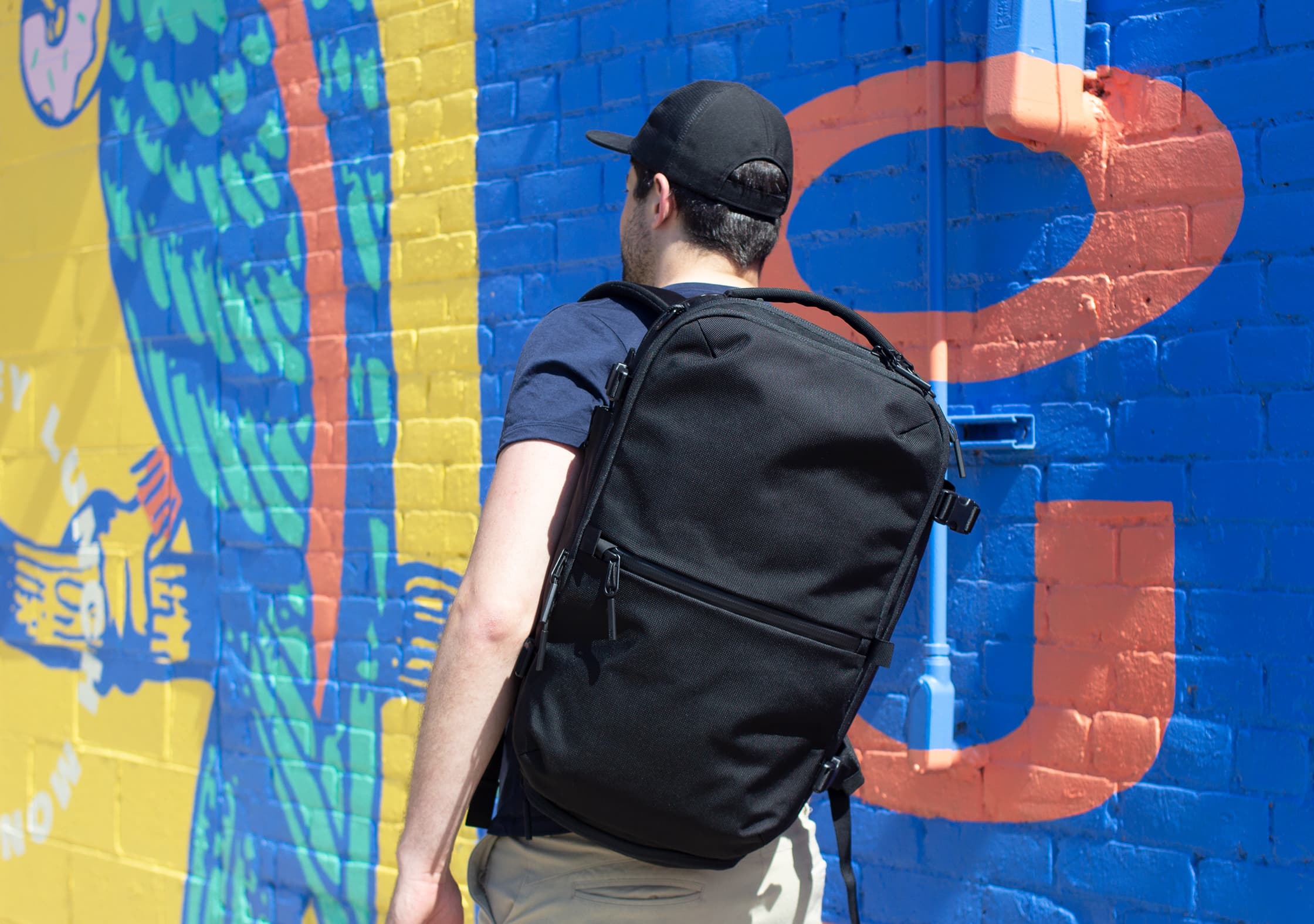
If you want to have a genuinely stress-free travel experience, we highly recommend practicing your trip before you leave. Yes, we know this sounds ridiculous. Just hear us out.
Once you’ve got your packing list figured out, go ahead and grab all your gear and pack it up in your backpack or suitcase. It can also help to lay out everything on the ground or a big table to review all the items you’re going to bring.
Once you’ve got your bag packed up, just go about your day. Go to work or go about your normal routines with nothing but the stuff in your luggage, and act as if your home is your hotel room. We like to do this for a couple of days to really sort out all the possible kinks—and because this stuff is pretty much our lives—but just one day can do wonders. The benefit of doing multiple days is you can get pretty granular and figure out how many clothes you need to pack.
You’ll figure out pretty quickly what you need, what you don’t, and how much stuff you can actually fit in your pack. And it’s fun! (At least, we think so.)
Preparing Before Leaving
Coming home to a clean space has to be one of the best feelings ever. Thinking ahead can save you some brain space and time. No one wants to worry about paying past bills right when you walk through the door or washing those three week old dishes—gross. Take some extra time before leaving to iron these things out! You’ll thank yourself later (and us, for reminding you).
- If you haven’t already, opt out of paper bills and access them online. That way you can be reminded of any bills on-the-go via email. If you don’t plan to be online during your trip, pre-pay any bills ahead of time.
- Don’t do any significant food shopping before you leave. Outside of grabbing some snacks for your trip, you’re better off avoiding the grocery store as your trip gets nearer. No one wants to come home to spoiled milk and moldy strawberries. Chances are you have some pantry items hidden in the corners of your fridge and cupboards waiting to be eaten—this is their time to shine. Don’t let it go to waste!
- If you have any furry friends, plants that need attending, or even a couple of fish, ask a neighbor or trustworthy individual to take care of them while you’re away.
- Ask your local post office to hold your mail, or contact a friend or family member to collect these on a daily or weekly basis for you.
- If you are taking vacation days or plan to be away from your computer, make sure to create an automatic email reply ensuring contacts you will be in touch once your trip is over, or that your response time will be delayed.
- Turn off your air conditioner or heater. Check out Nest to access your thermostat and more while traveling away from home.
- Turn off all your lights and consider unplugging some of your appliances before heading to the airport. This will decrease your electric bill and conserve energy! (Just don’t unplug necessary things like heaters or refrigerators!
- You know to lock your doors, but make sure all of your windows are locked as well!
Most importantly, don’t stress yourself out! These are all suggestions and lessons that we have learned over the years, after much trial and error. We want you to learn from our mistakes and have the most successful trip possible, no matter where your plane is touching down.
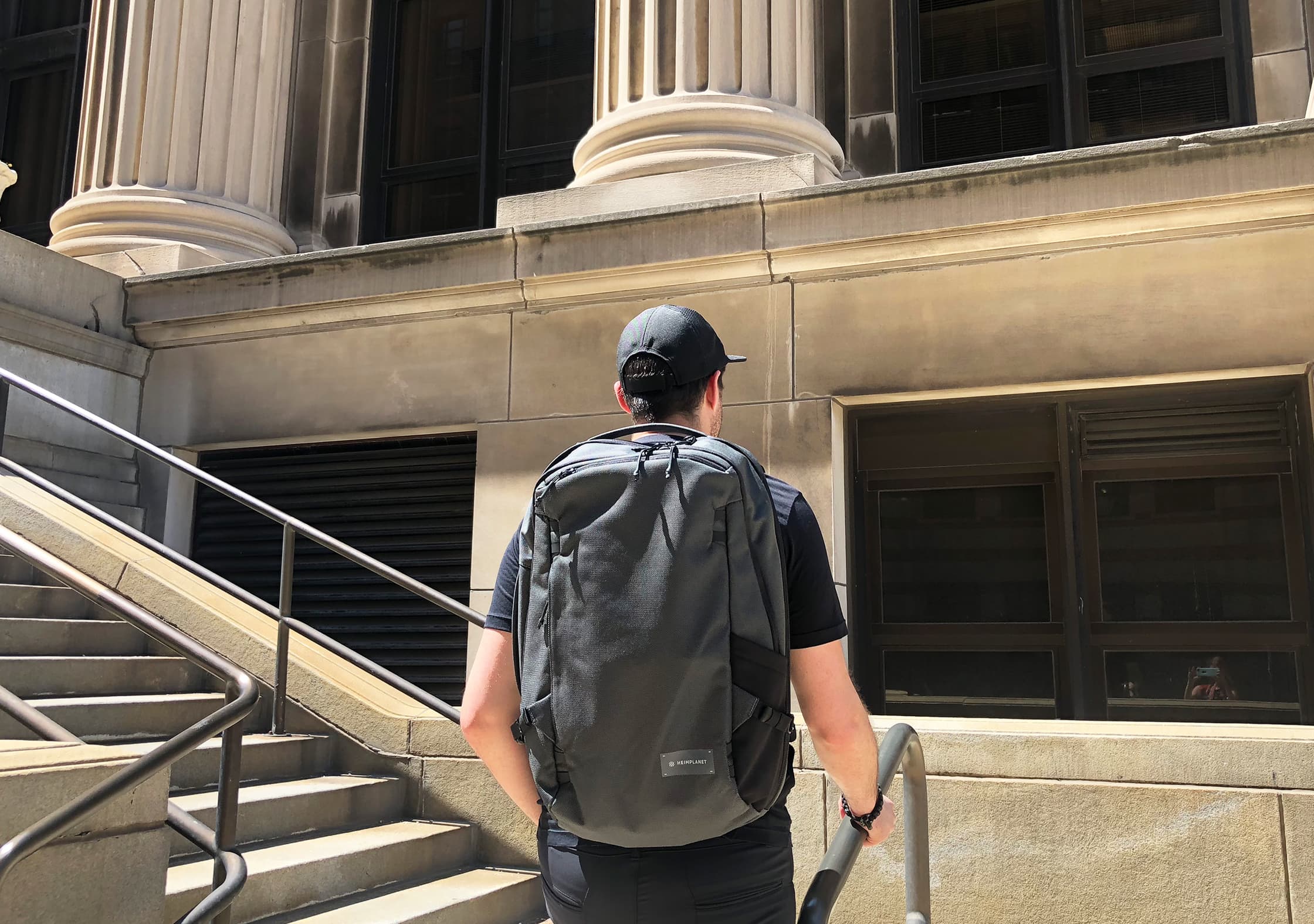
Traveling to new (and old) destinations can be incredibly exciting and a bit overwhelming at times. But with enough preparation and optimization—we know you’ll have a great adventure.
From all of us on the Pack Hacker team, good luck and bon voyage!
As always, feel free to drop us a line if you have questions or comments. We’d love to hear from you.
